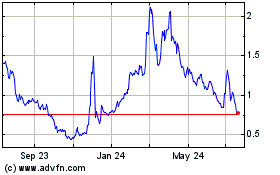UNITED STATES
SECURITIES AND EXCHANGE COMMISSION
Washington, D.C. 20549
FORM 6-K
Report of Foreign Private Issuer Pursuant to Rule 13a-16
or 15d-16
Under the Securities Exchange Act of 1934
For the Month of December 2023
Commission File Number: 001-41084
NeuroSense Therapeutics Ltd.
(Translation of registrant’s name into English)
11 HaMenofim Street, Building B
Herzliya 4672562 Israel
+972-9-799-6183
(Address of principal executive offices)
Indicate by check mark whether the registrant files
or will file annual reports under cover Form 20-F or Form 40-F.
Form 20-F ☒ Form 40-F ☐
NeuroSense Therapeutics Ltd.
(the “Company”) has made available an updated presentation about its business (the “Presentation”), a copy of
which is furnished herewith as Exhibit 99.1 to this Report on Form 6-K.
The Presentation
now contains, among others, information regarding the clinical efficacy results from the Phase 2b trial (PARADIGM) with the Company’s
lead drug candidate for amyotrophic lateral sclerosis (ALS), PrimeC.
The new
data in the Presentation is not an admission as to the materiality of any information therein. The information contained in the Presentation
is summary information that should be considered in the context of the Company’s filings with the Securities and Exchange Commission
and other public announcements the Company may make by press release or otherwise from time to time.
Exhibit Index
SIGNATURES
Pursuant to the requirements
of the Securities Exchange Act of 1934, the registrant has duly caused this report to be signed on its behalf by the undersigned, thereunto
duly authorized.
| |
NeuroSense Therapeutics Ltd. |
| |
|
|
| Date: December 21, 2023 |
By: |
/s/ Alon Ben-Noon |
| |
|
Alon Ben-Noon |
| |
|
Chief Executive Officer |
2
Exhibit 99.1
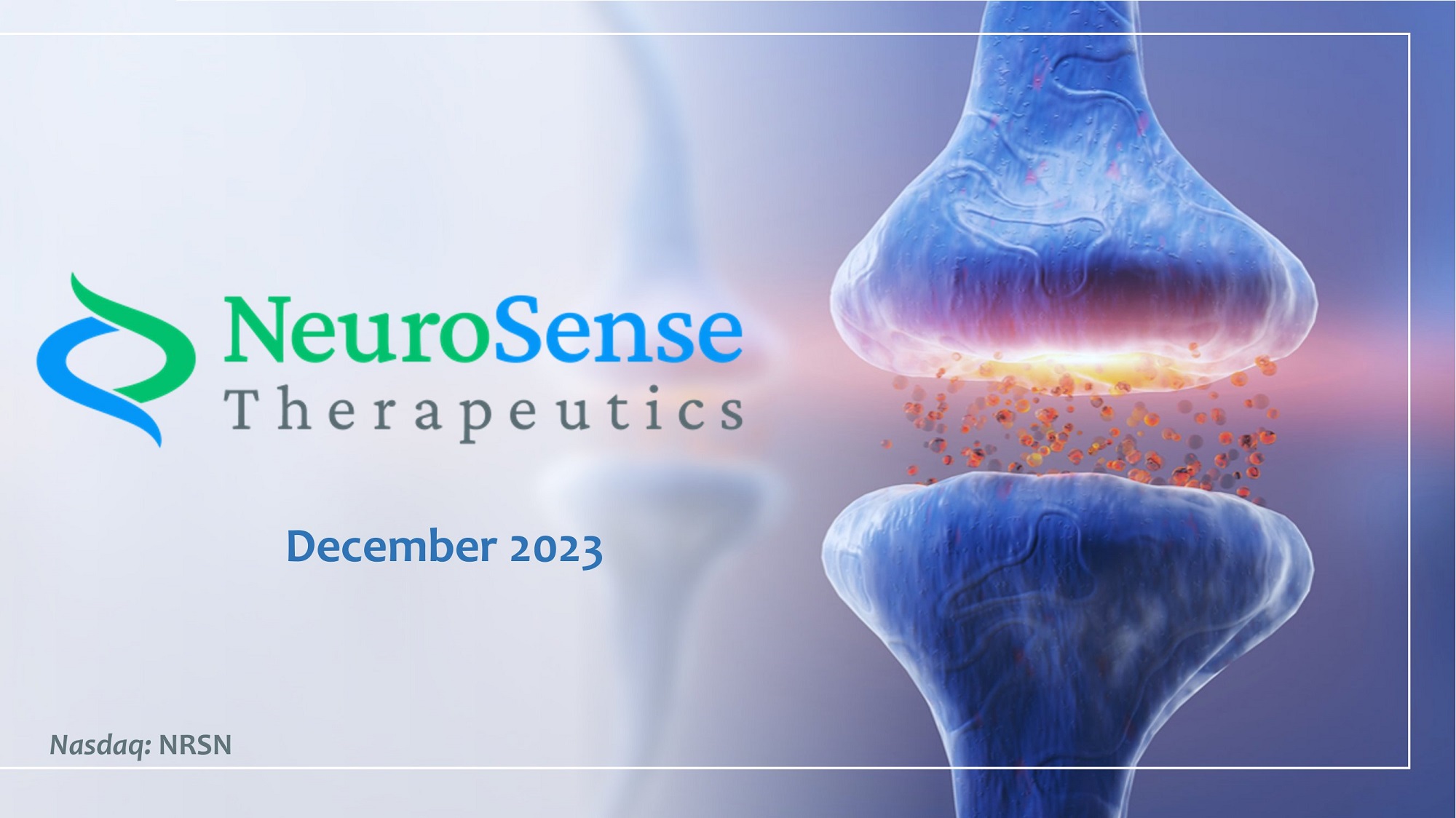
December 2023 Nasdaq: NRSN
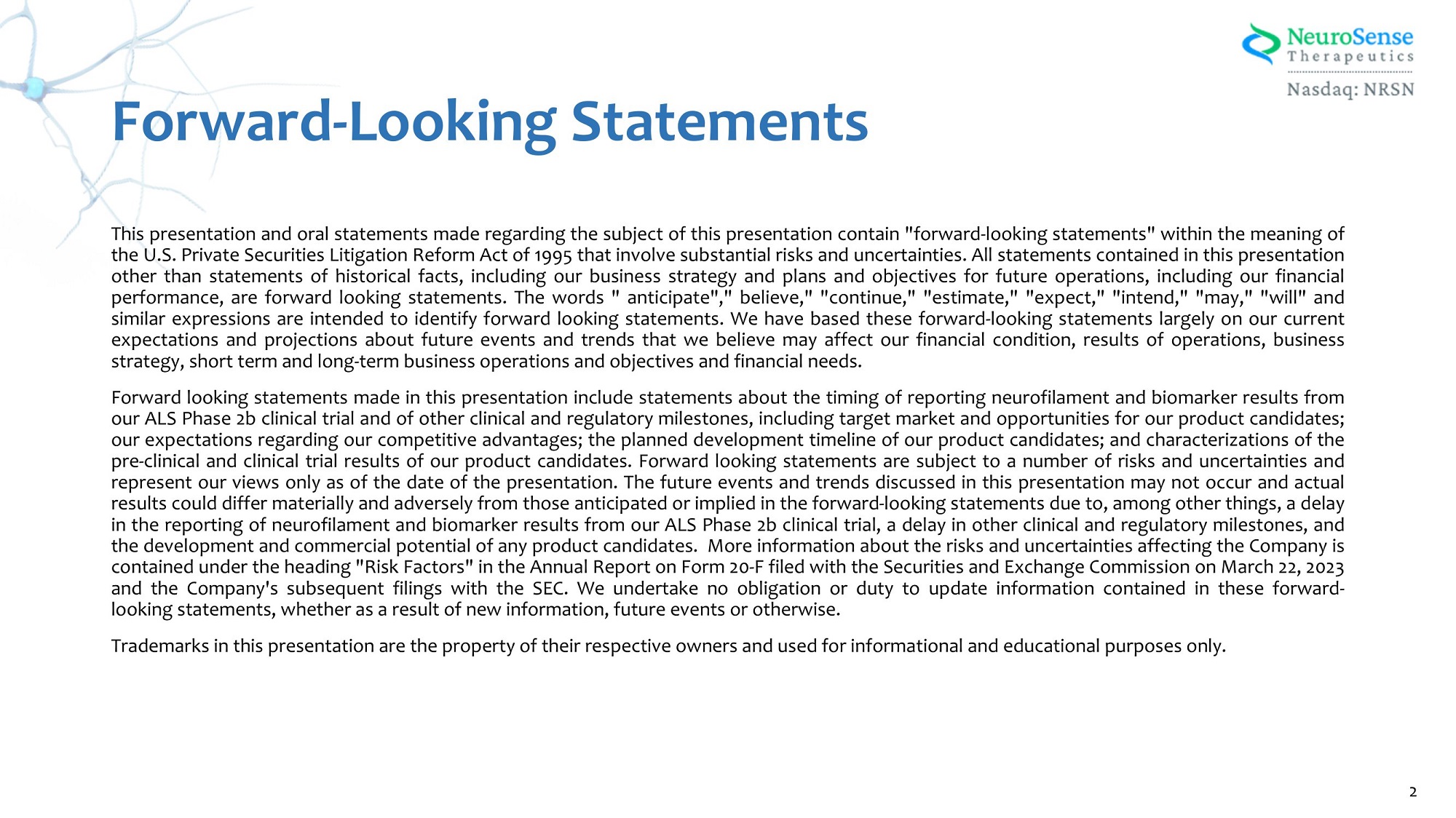
Forward - Looking Statements 2 This presentation and oral statements made regarding the subject of this presentation contain "forward - looking statements" within the meaning of the U . S . Private Securities Litigation Reform Act of 1995 that involve substantial risks and uncertainties . All statements contained in this presentation other than statements of historical facts, including our business strategy and plans and objectives for future operations, including our financial performance, are forward looking statements . The words " anticipate"," believe," "continue," "estimate," "expect," "intend," "may," "will" and similar expressions are intended to identify forward looking statements . We have based these forward - looking statements largely on our current expectations and projections about future events and trends that we believe may affect our financial condition, results of operations, business strategy, short term and long - term business operations and objectives and financial needs . Forward looking statements made in this presentation include statements about the timing of reporting neurofilament and biomarker results from our ALS Phase 2 b clinical trial and of other clinical and regulatory milestones, including target market and opportunities for our product candidates ; our expectations regarding our competitive advantages ; the planned development timeline of our product candidates ; and characterizations of the pre - clinical and clinical trial results of our product candidates . Forward looking statements are subject to a number of risks and uncertainties and represent our views only as of the date of the presentation . The future events and trends discussed in this presentation may not occur and actual results could differ materially and adversely from those anticipated or implied in the forward - looking statements due to, among other things, a delay in the reporting of neurofilament and biomarker results from our ALS Phase 2 b clinical trial, a delay in other clinical and regulatory milestones, and the development and commercial potential of any product candidates . More information about the risks and uncertainties affecting the Company is contained under the heading "Risk Factors" in the Annual Report on Form 20 - F filed with the Securities and Exchange Commission on March 22 , 2023 and the Company's subsequent filings with the SEC . We undertake no obligation or duty to update information contained in these forward - looking statements, whether as a result of new information, future events or otherwise . Trademarks in this presentation are the property of their respective owners and used for informational and educational purposes only .
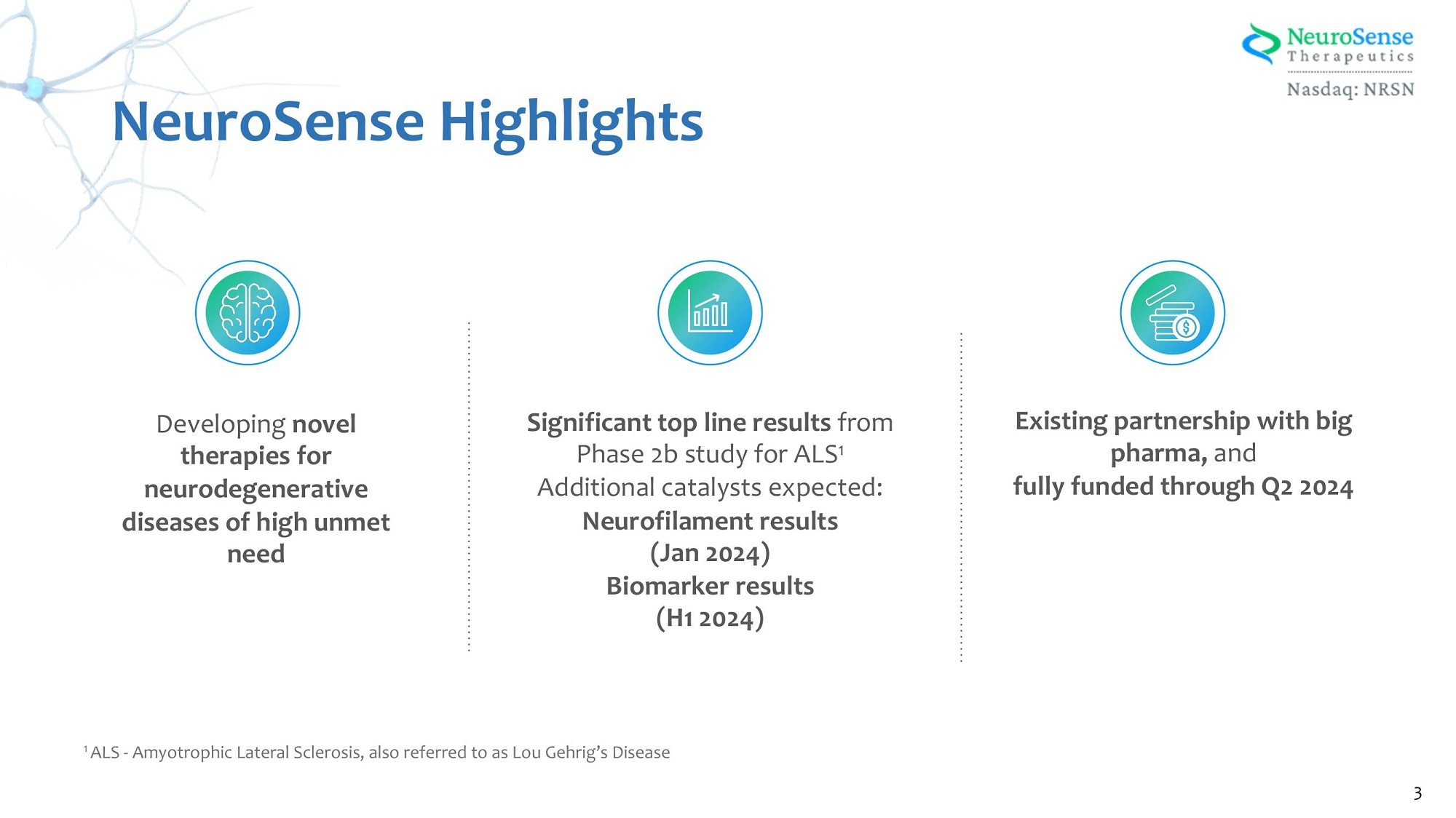
NeuroSense Highlights Developing novel therapies for neurodegenerative diseases of high unmet need Significant top line results from Phase 2b study for ALS 1 Additional catalysts expected: Neurofilament results (Jan 2024) Biomarker results (H1 2024) Existing partnership with big pharma, and fully funded through Q2 2024 1 ALS - Amyotrophic Lateral Sclerosis, also referred to as Lou Gehrig’s Disease 3
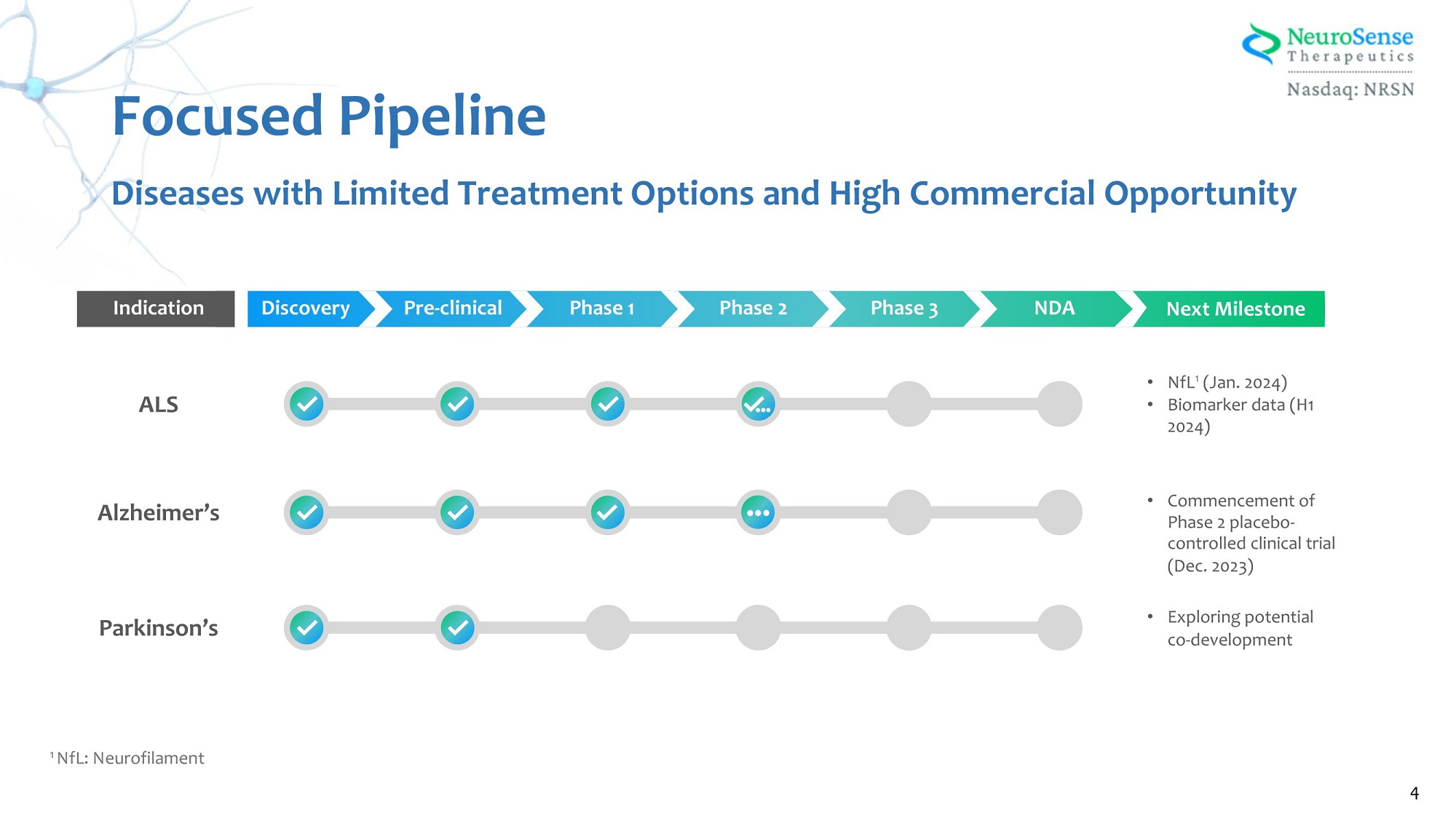
Focused Pipeline Diseases with Limited Treatment Options and High Commercial Opportunity ALS • NfL 1 (Jan. 2024) • Biomarker data (H1 2024) Discovery Pre - clinical Phase 1 Phase 2 Phase 3 NDA Indication Next Milestone Parkinson’s 4 • Exploring potential co - development Alzheimer’s • Commencement of Phase 2 placebo - controlled clinical trial (Dec. 2023) 1 NfL: Neurofilament
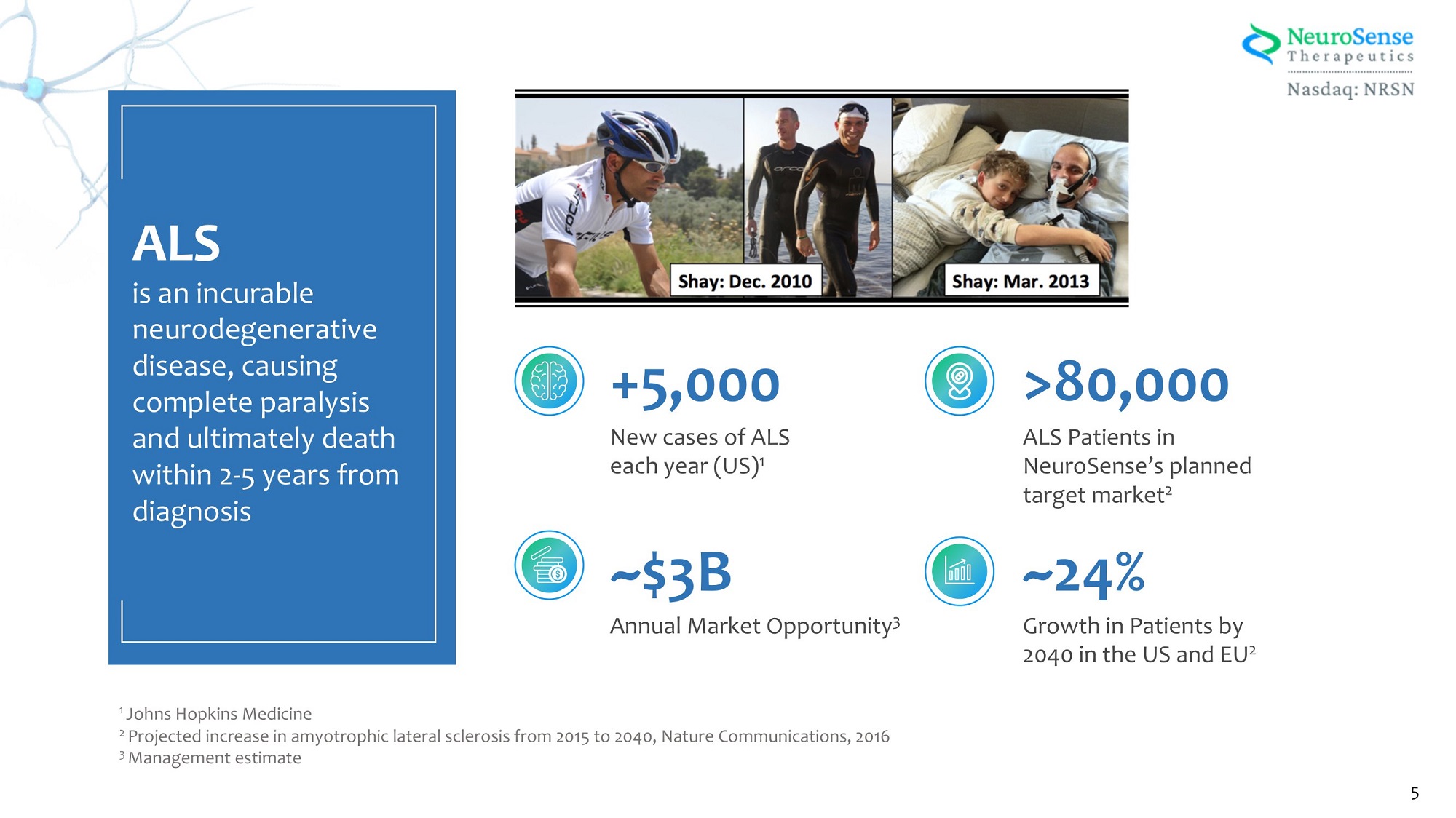
~24% Growth in Patients by 2040 in the US and EU 2 >80,000 ALS Patients in NeuroSense’s planned target market 2 +5,000 New cases of ALS each year (US) 1 ~$3B Annual Market Opportunity 3 1 Johns Hopkins Medicine 2 Projected increase in amyotrophic lateral sclerosis from 2015 to 2040, Nature Communications, 2016 3 Management estimate ALS is an incurable neurodegenerative disease, causing complete paralysis and ultimately death within 2 - 5 years from diagnosis 5
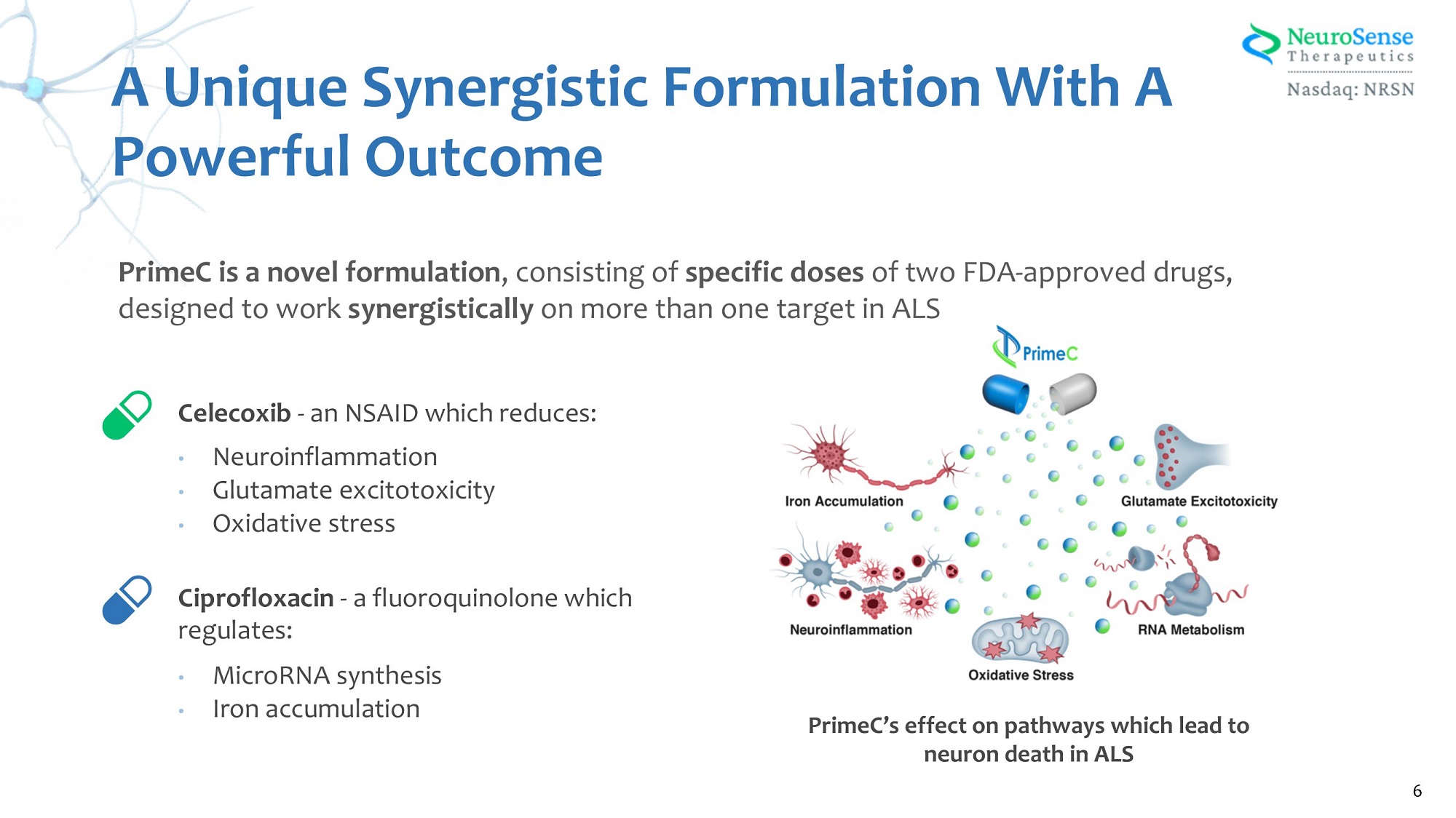
A Unique Synergistic Formulation With A Powerful Outcome • Iron accumulation PrimeC is a novel formulation , consisting of specific doses of two FDA - approved drugs, designed to work synergistically on more than one target in ALS Celecoxib - an NSAID which reduces: • Neuroinflammation • Glutamate excitotoxicity • Oxidative stress Ciprofloxacin - a fluoroquinolone which regulates: • MicroRNA synthesis PrimeC’s effect on pathways which lead to neuron death in ALS 6
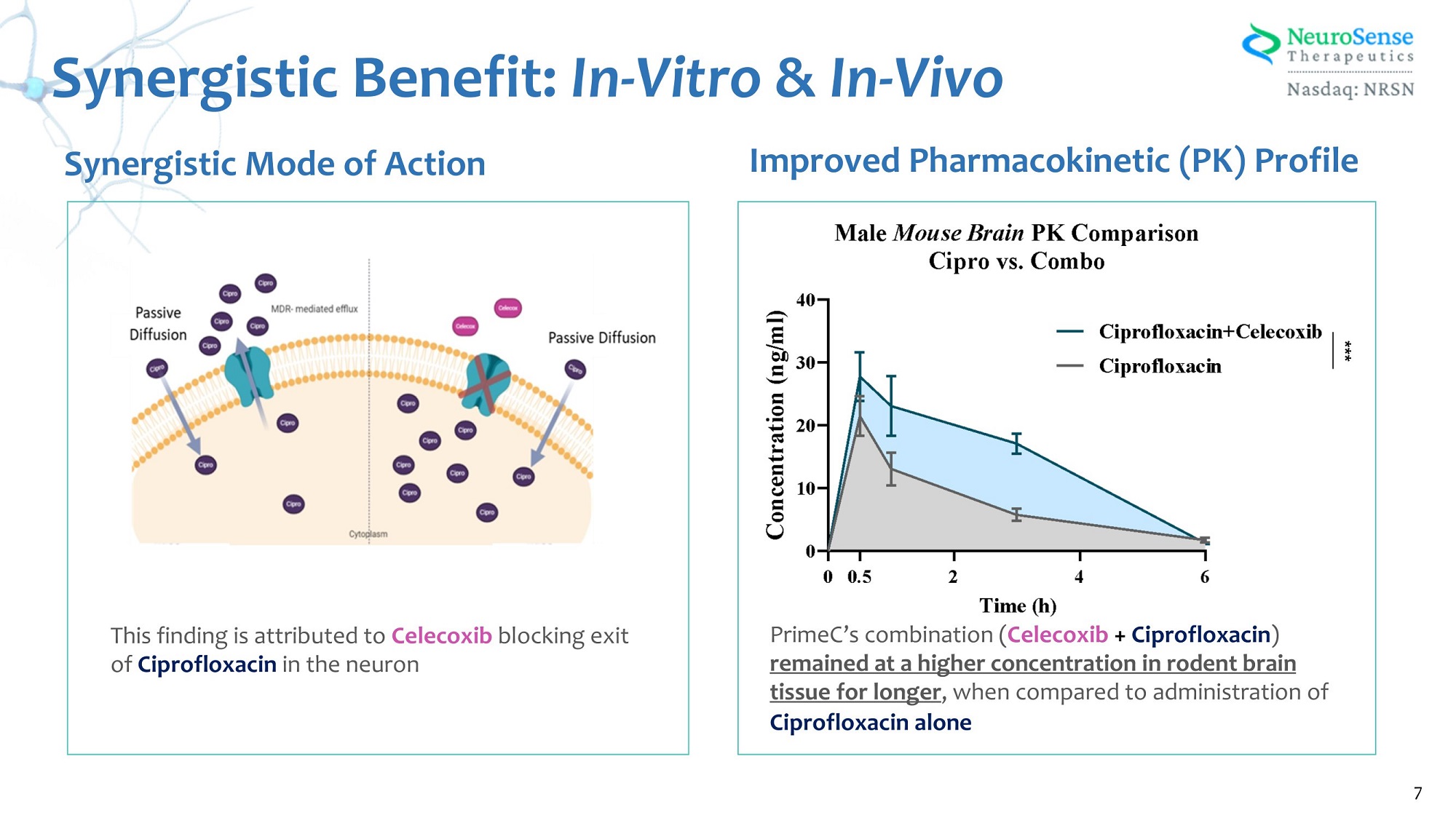
Synergistic Benefit: In - Vitro & In - Vivo This finding is attributed to Celecoxib blocking exit of Ciprofloxacin in the neuron PrimeC’s combination ( Celecoxib + Ciprofloxacin ) remained at a higher concentration in rodent brain tissue for longer , when compared to administration of Ciprofloxacin alone *** Synergistic Mode of Action 7 Improved Pharmacokinetic (PK) Profile
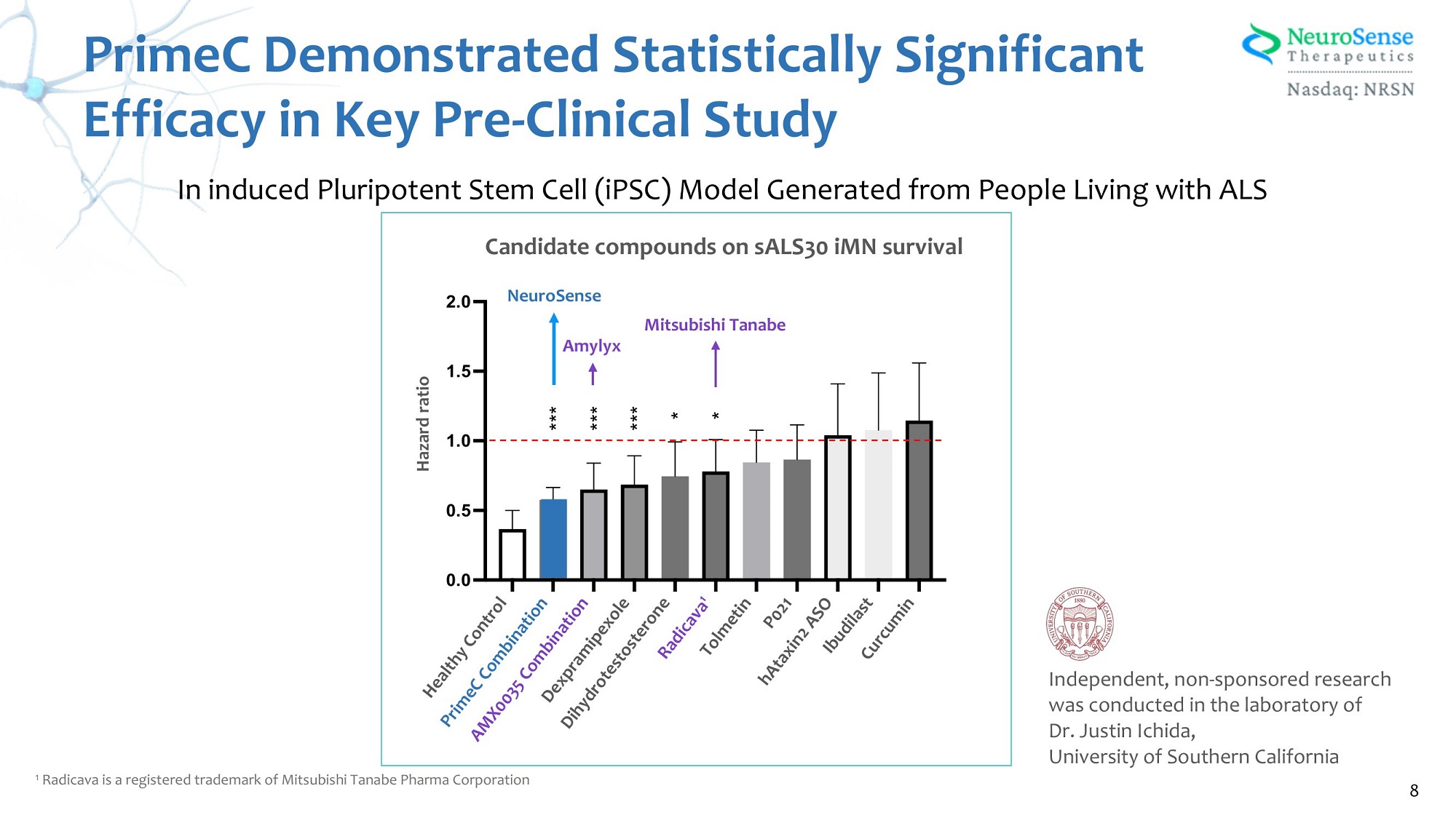
Independent, non - sponsored research was conducted in the laboratory of Dr. Justin Ichida, University of Southern California PrimeC Demonstrated Statistically Significant Efficacy in Key Pre - Clinical Study * p<0.05 ***p<0.0 * = p<0.05, *** = p<0.001 01 *** *** *** * * NeuroSense 2.0 Hazard Ratio Candidate Compounds on sALS30 iMN Survival Mitsubishi Tanabe Amylyx 1.5 1.0 0.5 0.0 In induced Pluripotent Stem Cell (iPSC) Model Generated from People Living with ALS Candidate compounds on sALS30 iMN survival Hazard ratio NeuroSense 1 Radicava is a registered trademark of Mitsubishi Tanabe Pharma Corporation 8
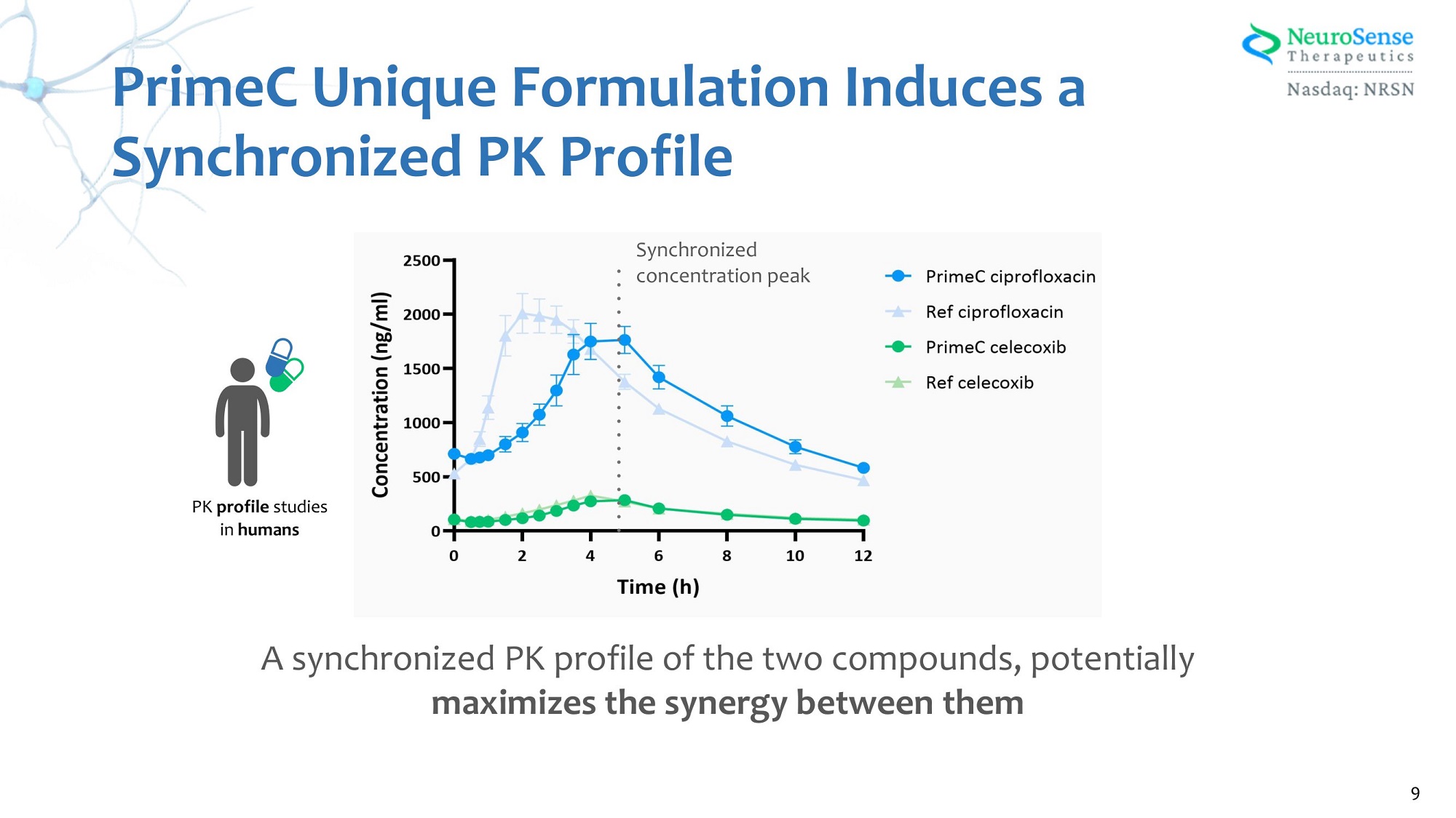
A synchronized PK profile of the two compounds, potentially maximizes the synergy between them PK profile studies in humans Synchronized concentration peak 9 PrimeC Unique Formulation Induces a Synchronized PK Profile
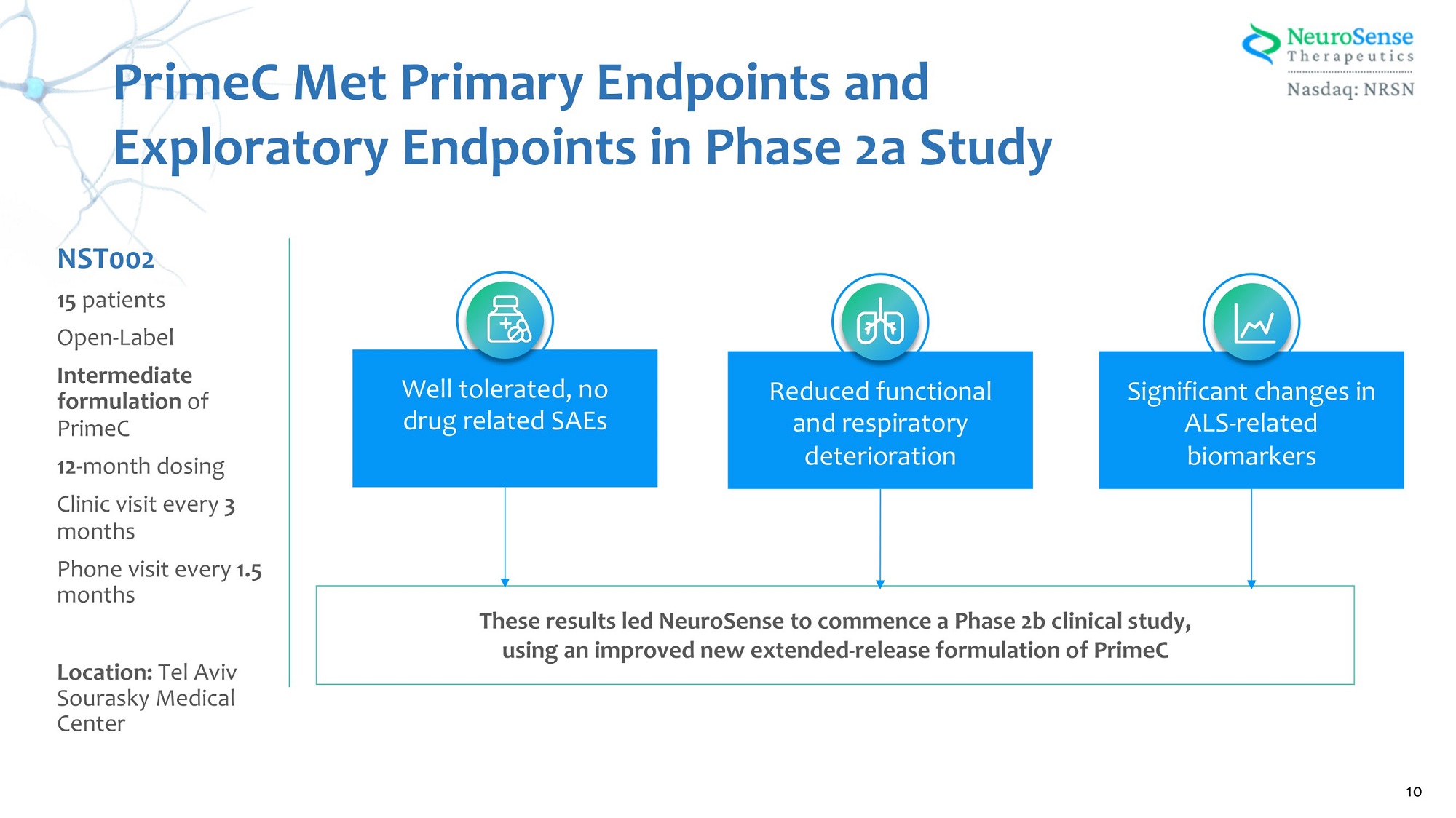
These results led NeuroSense to commence a Phase 2b clinical study, using an improved new extended - release formulation of PrimeC Significant changes in ALS - related biomarkers Well tolerated, no drug related SAEs Reduced functional and respiratory deterioration NST002 15 patients Open - Label Intermediate formulation of PrimeC 12 - month dosing Clinic visit every 3 10 months Phone visit every 1.5 months Location : Tel Aviv Sourasky Medical Center PrimeC Met Primary Endpoints and Exploratory Endpoints in Phase 2a Study
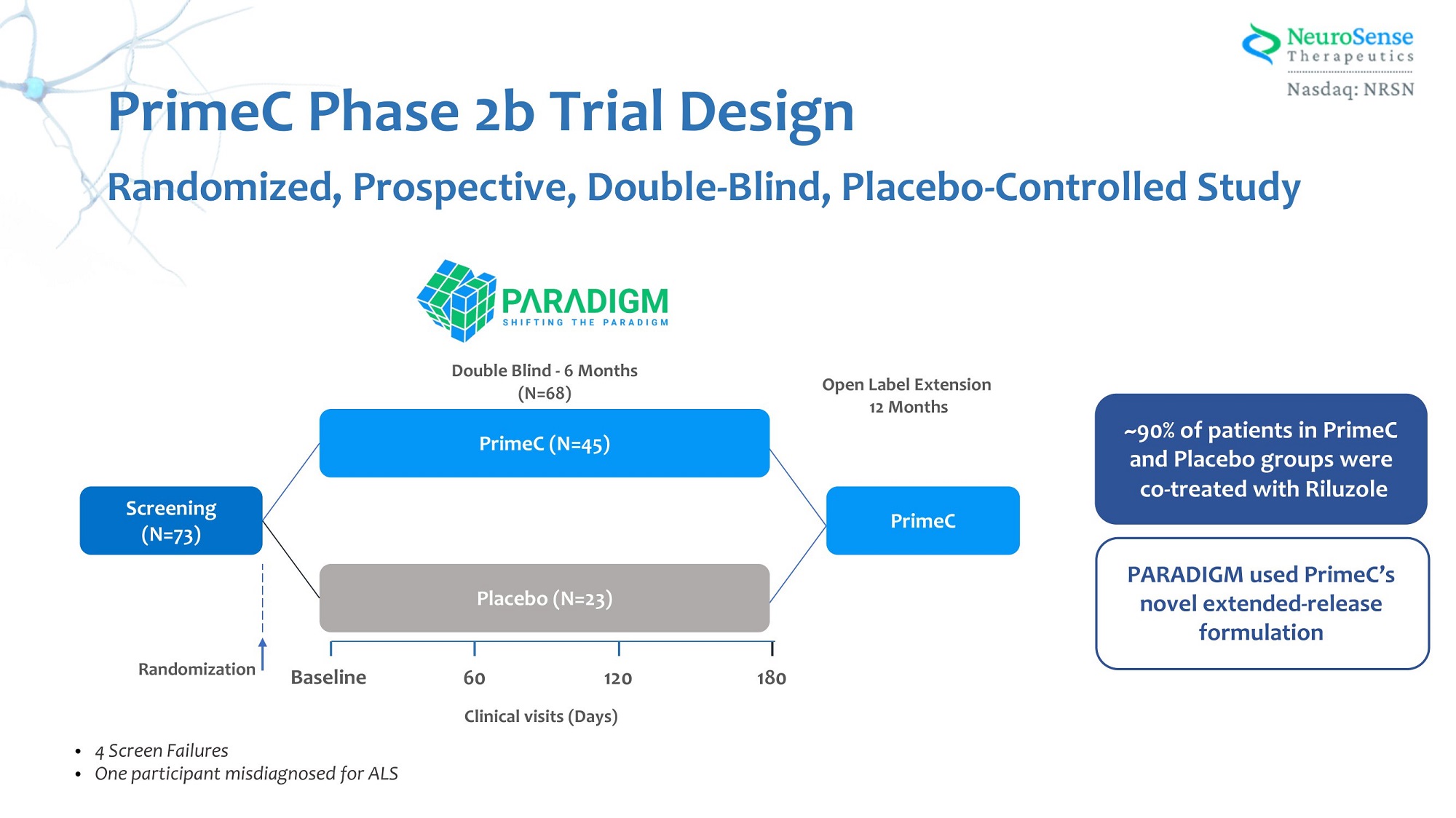
Screening (N=73) PrimeC (N=45) Placebo (N=23) Baseline 180 60 120 Clinical visits (Days) Double Blind - 6 Months (N=68) PrimeC Open Label Extension 12 Months ~ 90 % of patients in PrimeC and Placebo groups were co - treated with Riluzole PARADIGM used PrimeC’s novel extended - release formulation PrimeC Phase 2b Trial Design Randomized, Prospective, Double - Blind, Placebo - Controlled Study • • 4 Screen Failures One participant misdiagnosed for ALS Randomization
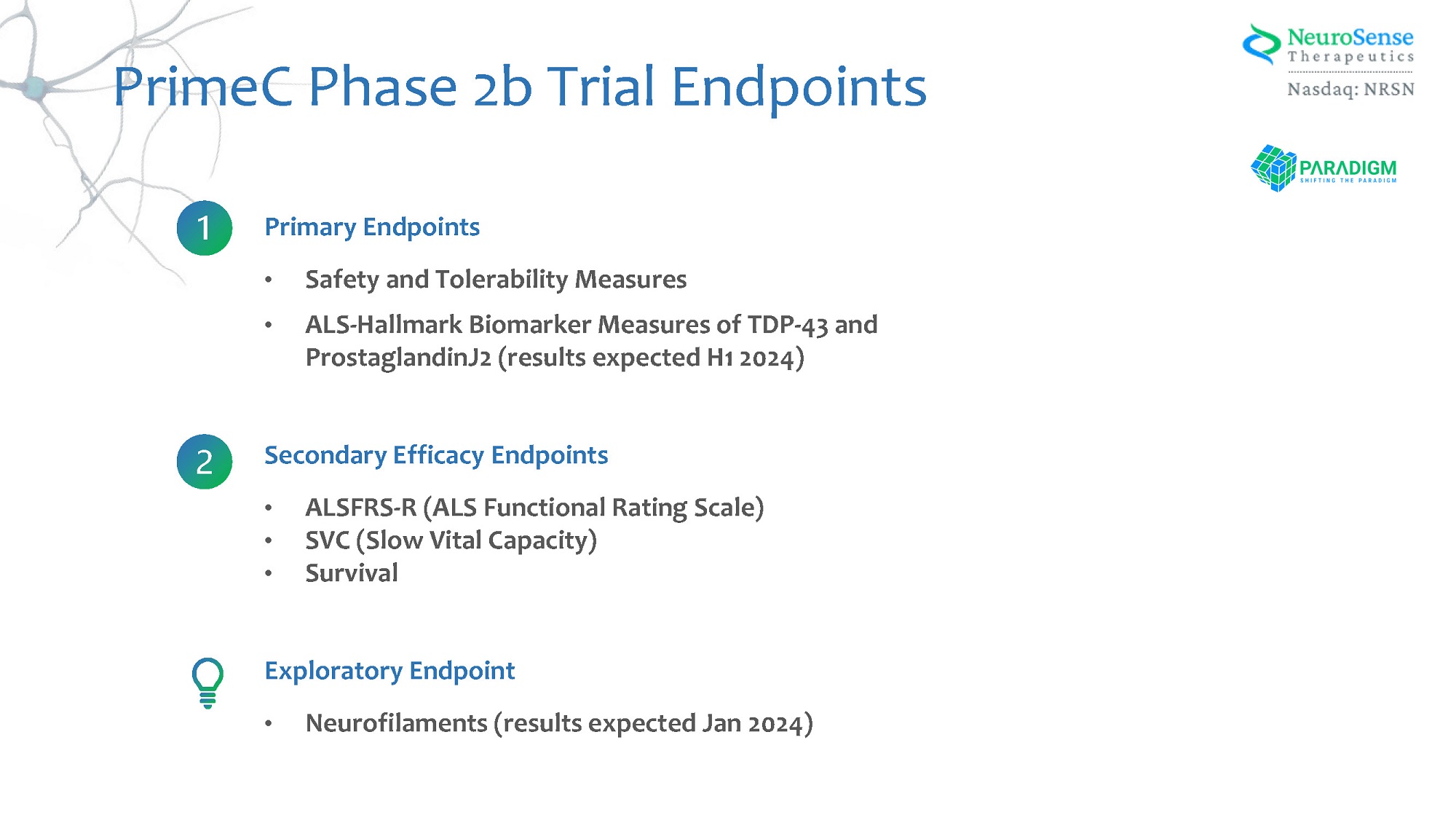
Primary Endpoints • Safety and Tolerability Measures • ALS - Hallmark Biomarker Measures of TDP - 43 and ProstagladinJ2 (results expected H1 2024) Secondary Efficacy Endpoints • ALSFRS - R (ALS Functional Rating Scale) • SVC (Slow Vital Capacity) • Survival Exploratory Endpoint • Neurofilaments (results expected Jan 2024) PrimeC Phase 2b Trial Endpoints
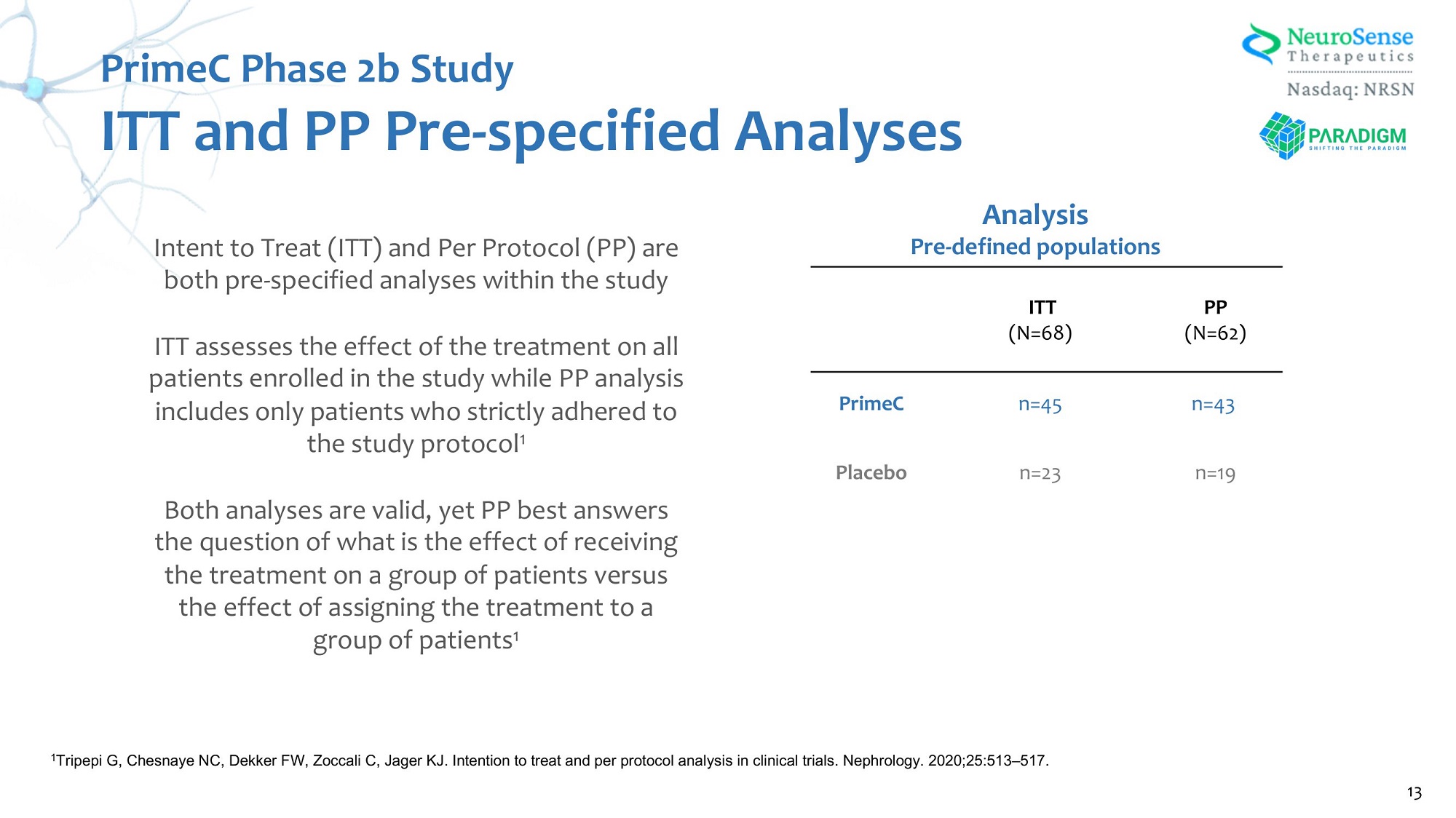
PrimeC Phase 2b Study ITT and PP Pre - specified Analyses PP (N=62) ITT (N=68) n=43 n=45 PrimeC n=19 n=23 Placebo Intent to Treat (ITT) and Per Protocol (PP) are both pre - specified analyses within the study 13 ITT assesses the effect of the treatment on all patients enrolled in the study while PP analysis includes only patients who strictly adhered to the study protocol 1 Both analyses are valid, yet PP best answers the question of what is the effect of receiving the treatment on a group of patients versus the effect of assigning the treatment to a group of patients 1 1 Tripepi G, Chesnaye NC, Dekker FW, Zoccali C, Jager KJ. Intention to treat and per protocol analysis in clinical trials. Nephrology. 2020;25:513 – 517. Analysis Pre - defined populations
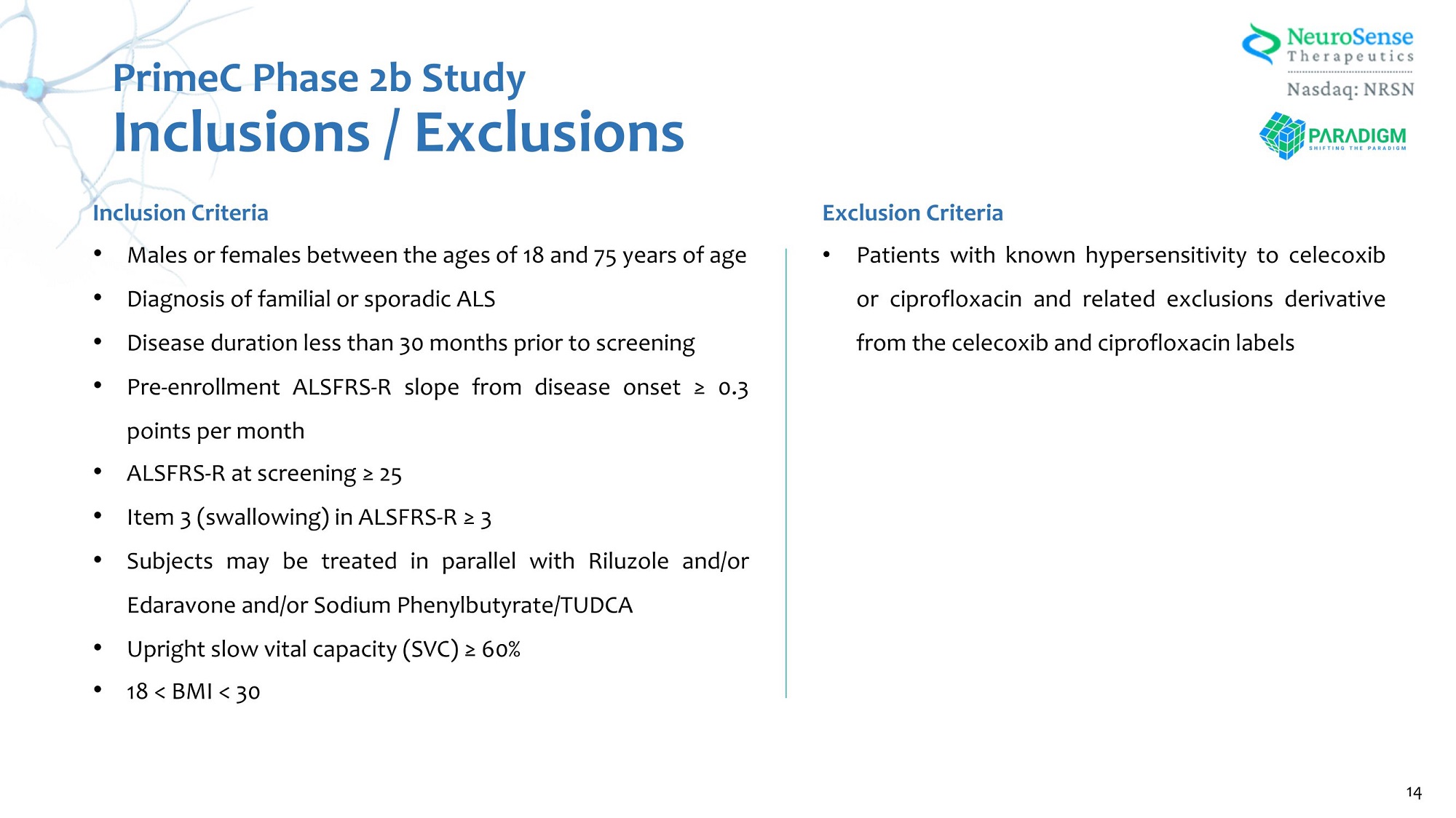
PrimeC Phase 2b Study Inclusions / Exclusions Inclusion Criteria • Males or females between the ages of 18 and 75 years of age • Diagnosis of familial or sporadic ALS • Disease duration less than 30 months prior to screening • Pre - enrollment ALSFRS - R slope from disease onset ≥ 0.3 points per month • ALSFRS - R at screening ≥ 25 • Item 3 (swallowing) in ALSFRS - R ≥ 3 • Subjects may be treated in parallel with Riluzole and/or Edaravone and/or Sodium Phenylbutyrate/TUDCA • Upright slow vital capacity (SVC) ≥ 60% • 18 < BMI < 30 Exclusion Criteria • Patients with known hypersensitivity to celecoxib or ciprofloxacin and related exclusions derivative from the celecoxib and ciprofloxacin labels 14
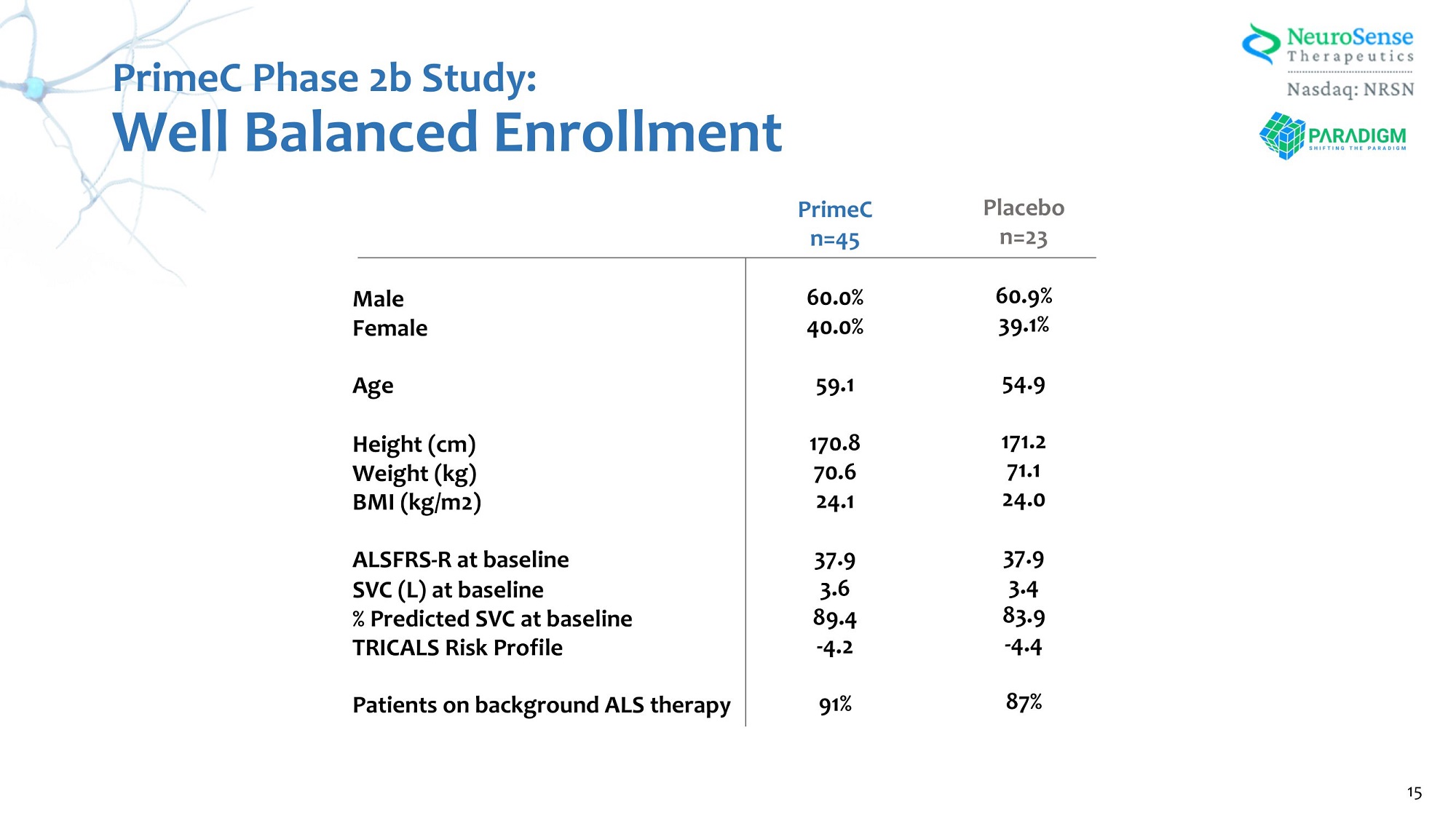
PrimeC Phase 2b Study: Well Balanced Enrollment Male Female Age Height (cm) Weight (kg) BMI (kg/m 2 ) ALSFRS - R at baseline SVC (L) at baseline % Predicted SVC at baseline TRICALS Risk Profile Patients on background ALS therapy Placebo n=23 60.9% 39.1% 54.9 171.2 71.1 24.0 37.9 3.4 83.9 - 4.4 87% PrimeC n=45 60.0% 40.0% 59.1 170.8 70.6 24.1 37.9 3.6 89.4 - 4.2 91% 15
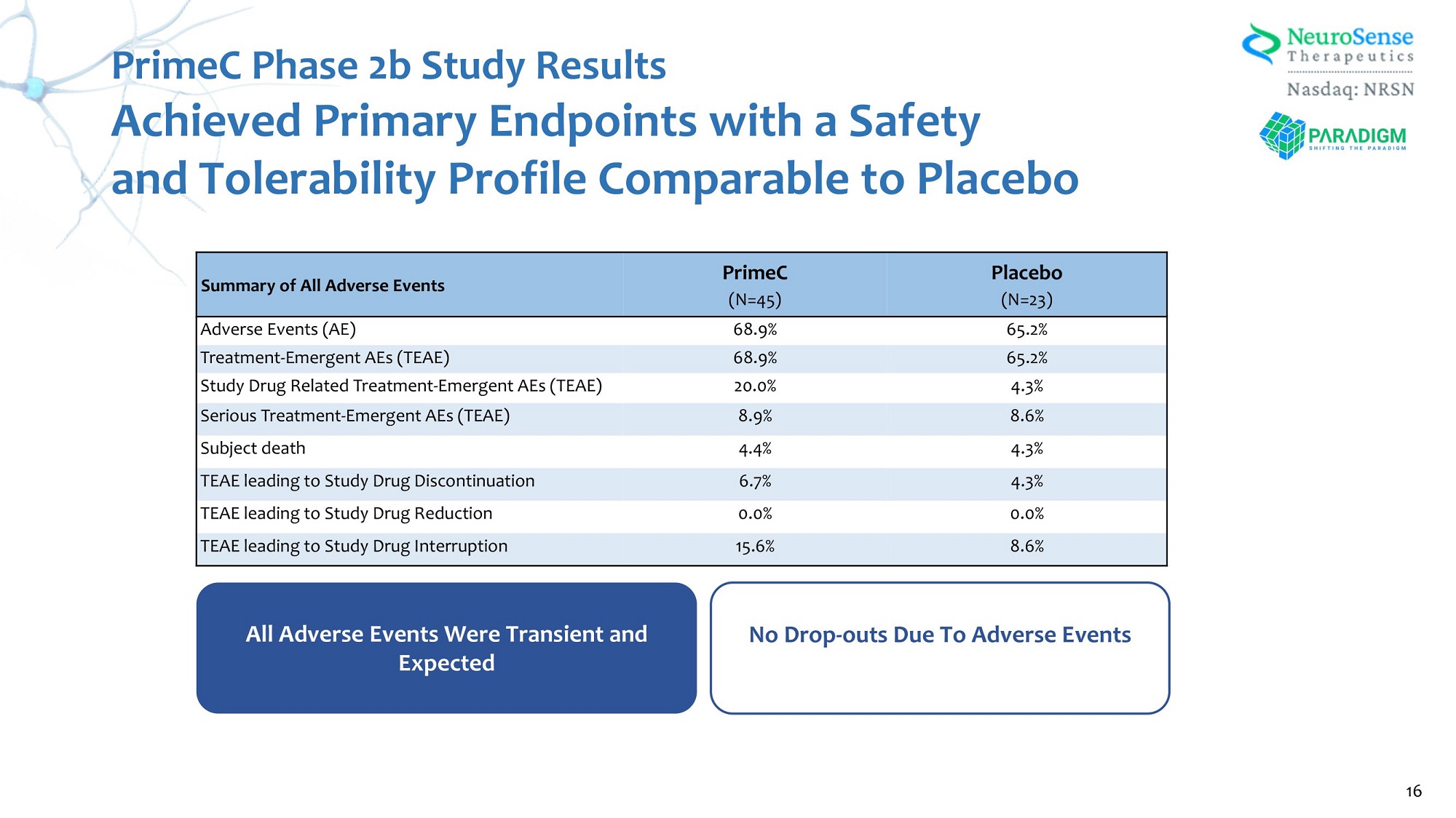
Placebo (N=23) PrimeC (N=45) Summary of All Adverse Events 65.2% 68.9% Adverse Events (AE) 65.2% 68.9% Treatment - Emergent AEs (TEAE) 4.3% 20.0% Study Drug Related Treatment - Emergent AEs (TEAE) 8.6% 8.9% Serious Treatment - Emergent AEs (TEAE) 4.3% 4.4% Subject death 4.3% 6.7% TEAE leading to Study Drug Discontinuation 0.0% 0.0% TEAE leading to Study Drug Reduction 8.6% 15.6% TEAE leading to Study Drug Interruption PrimeC Phase 2b Study Results Achieved Primary Endpoints with a Safety and Tolerability Profile Comparable to Placebo All Adverse Events Were Transient and Expected No Drop - outs Due To Adverse Events 16
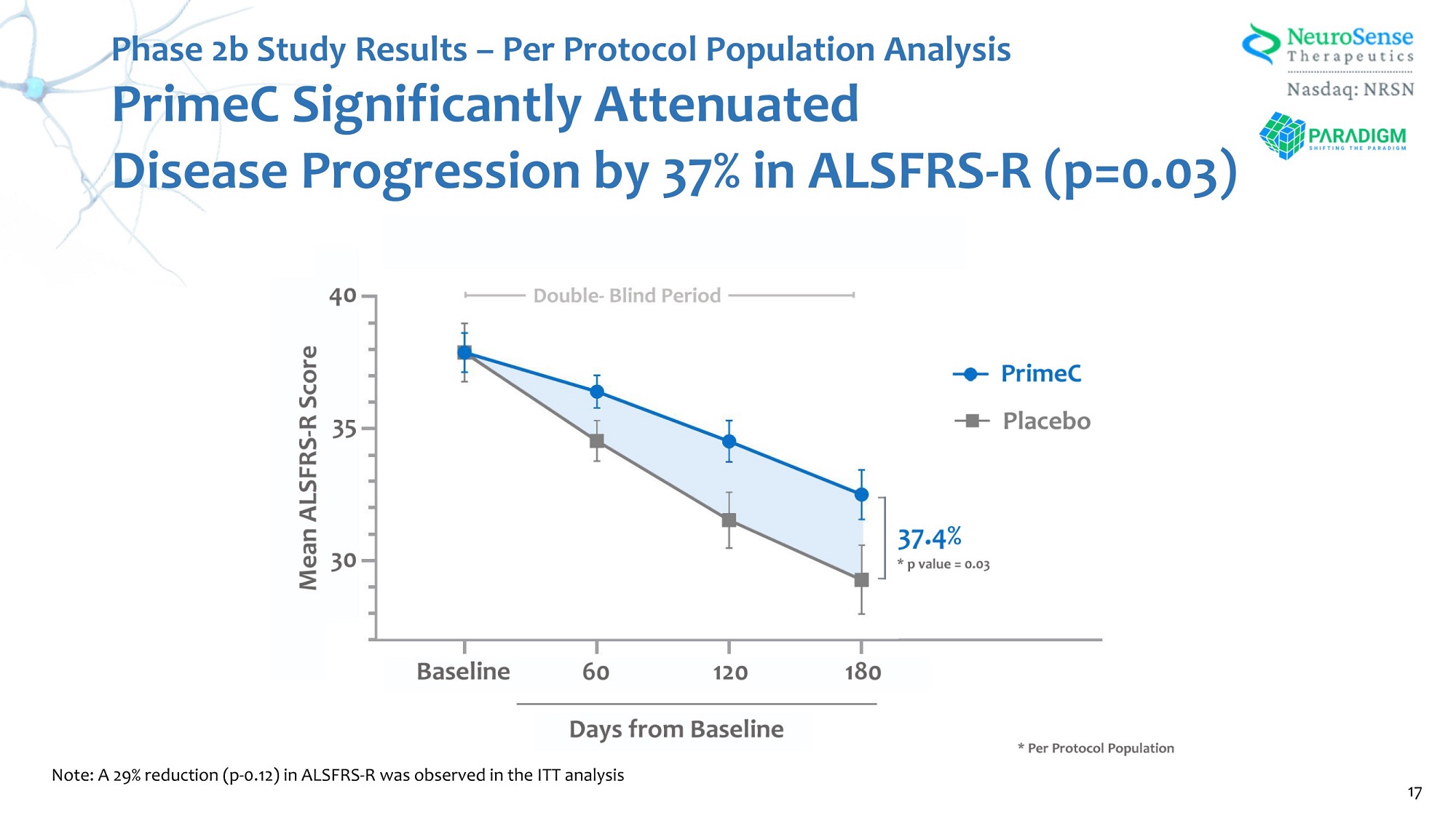
Phase 2b Study Results – Per Protocol Population Analysis PrimeC Significantly Attenuated Disease Progression by 37% in ALSFRS - R (p=0.03) Note: A 29% reduction (p - 0.12) in ALSFRS - R was observed in the ITT analysis 17
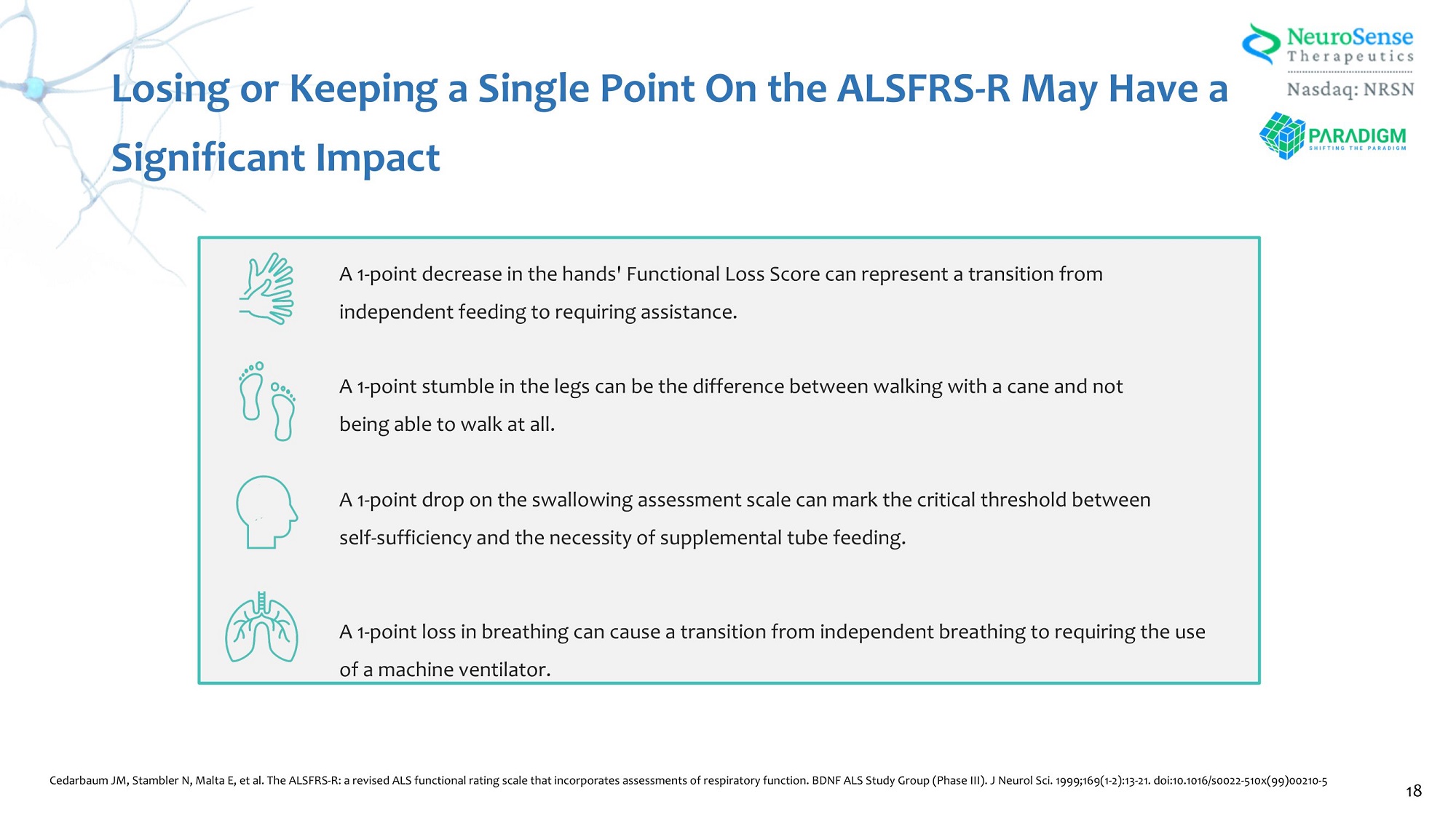
Losing or Keeping a Single Point On the ALSFRS - R May Have a Significant Impact A 1 - point decrease in the hands' Functional Loss Score can represent a transition from independent feeding to requiring assistance. A 1 - point stumble in the legs can be the difference between walking with a cane and not being able to walk at all. A 1 - point drop on the swallowing assessment scale can mark the critical threshold between self - sufficiency and the necessity of supplemental tube feeding. A 1 - point loss in breathing can cause a transition from independent breathing to requiring the use of a machine ventilator. Cedarbaum JM, Stambler N, Malta E, et al. The ALSFRS - R: a revised ALS functional rating scale that incorporates assessments of respiratory function. BDNF ALS Study Group (Phase III). J Neurol Sci. 1999;169(1 - 2):13 - 21. doi:10.1016/s0022 - 510x(99)00210 - 5 18
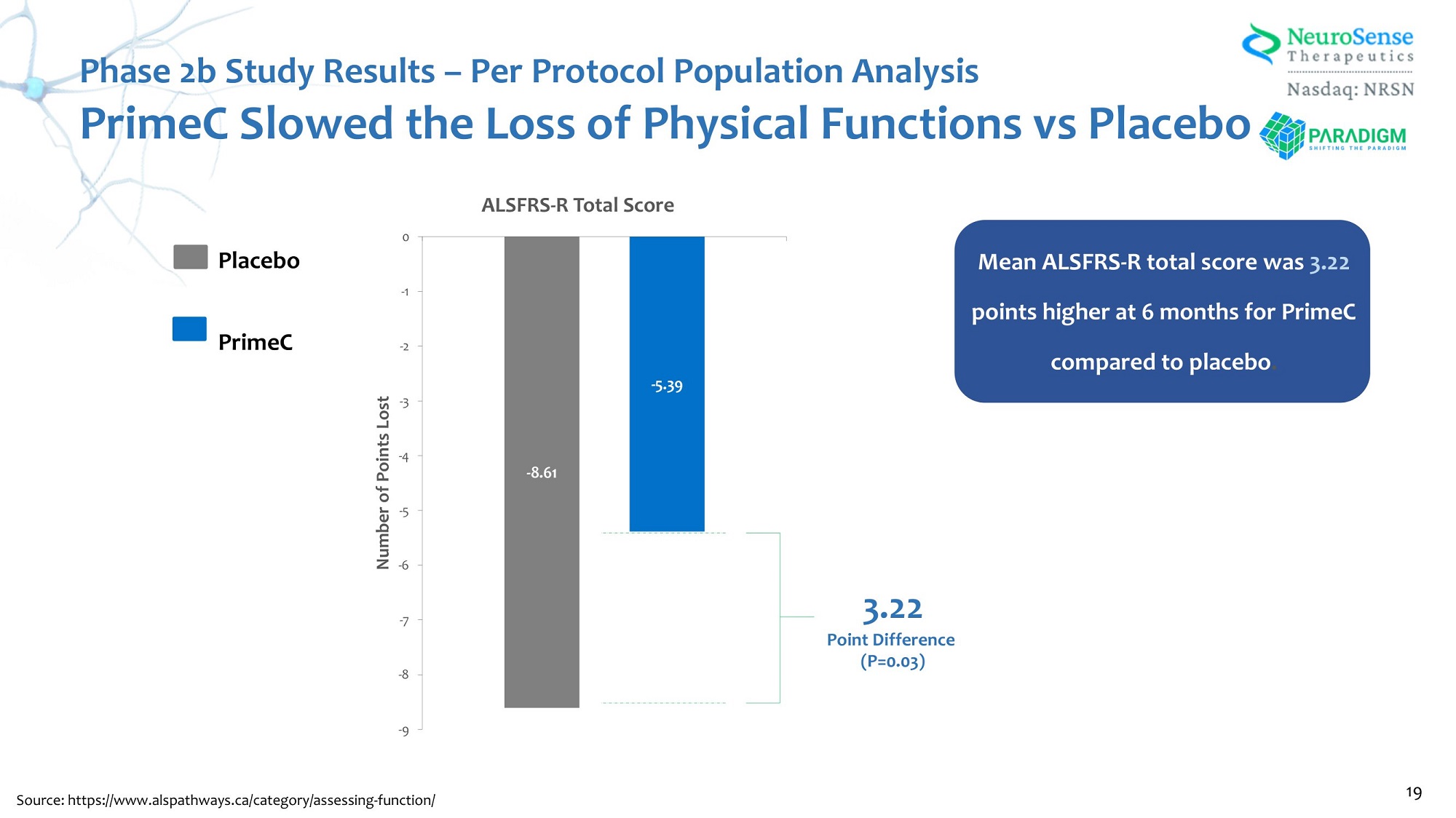
Phase 2b Study Results – Per Protocol Population Analysis PrimeC Slowed the Loss of Physical Functions vs Placebo - 8.61 - 5.39 - 9 - 8 - 7 - 5 - 6 - 3 - 4 - 2 - 1 0 Number of Points Lost ALSFRS - R Total Score 3.22 Point Difference (P=0.03) Mean ALSFRS - R total score was 3.22 19 Source: https:// www.alspathways.ca/category/assessing - function/ points higher at 6 months for PrimeC compared to placebo . Placebo PrimeC
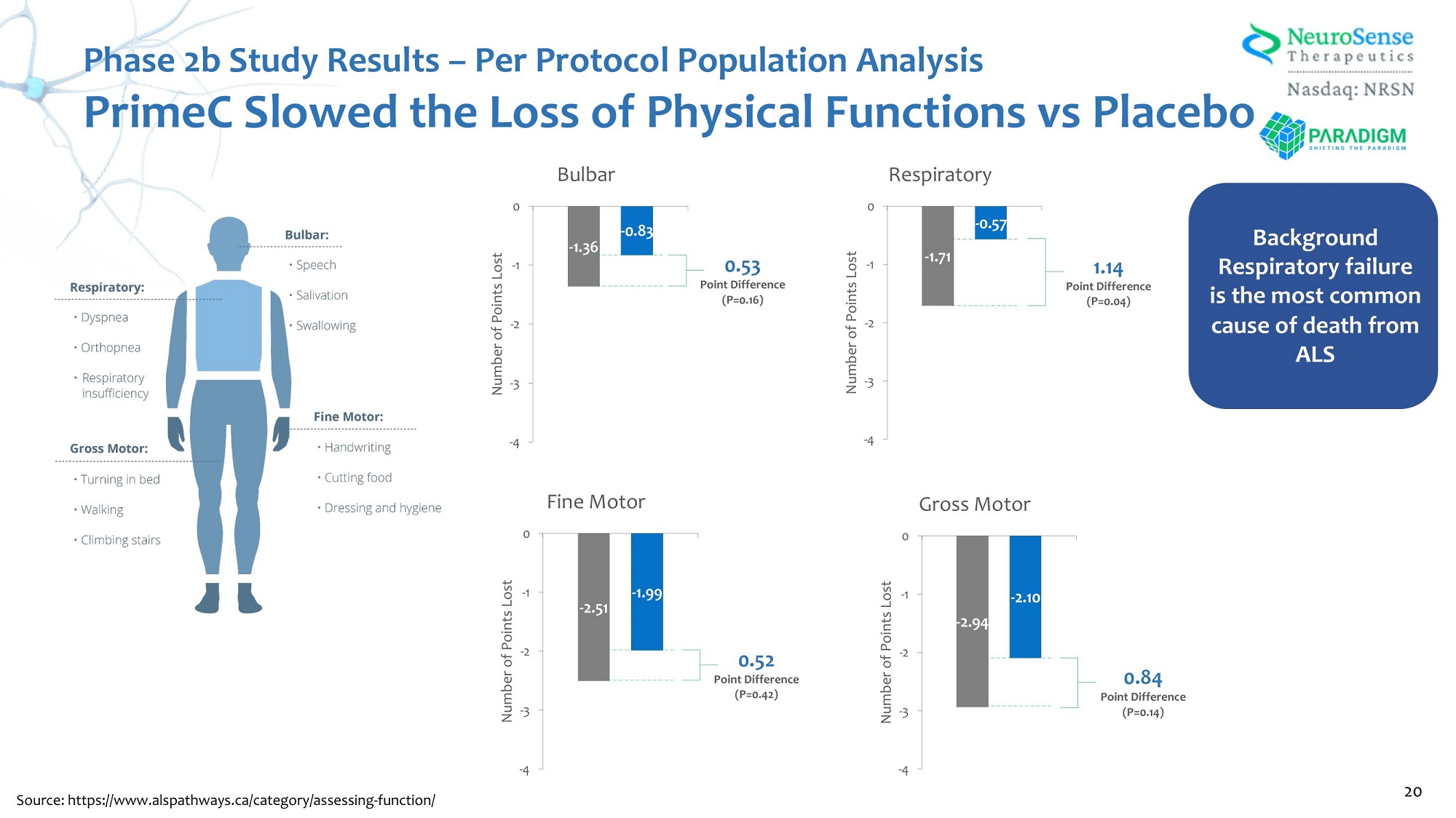
Phase 2b Study Results – Per Protocol Population Analysis PrimeC Slowed the Loss of Physical Functions vs Placebo - 2.51 - 1.99 - 4 - 3 - 2 - 1 0 Number of Points Lost Fine Motor 0.52 Point Difference (P=0.42) - 1.36 - 0.83 - 4 - 3 - 2 - 1 Number of Points Lost 0.53 Point Difference (P=0.16) 0 0 Bulbar Respiratory - 2.94 - 2.10 - 4 - 3 - 2 - 1 0 Number of Points Lost Gross Motor 0.84 Point Difference (P=0.14) - 1.71 - 0.57 - 4 - 3 - 2 - 1 Number of Points Lost 1.14 Point Difference (P=0.04) Background Respiratory failure is the most common cause of death from ALS 20 Source: https:// www.alspathways.ca/category/assessing - function/
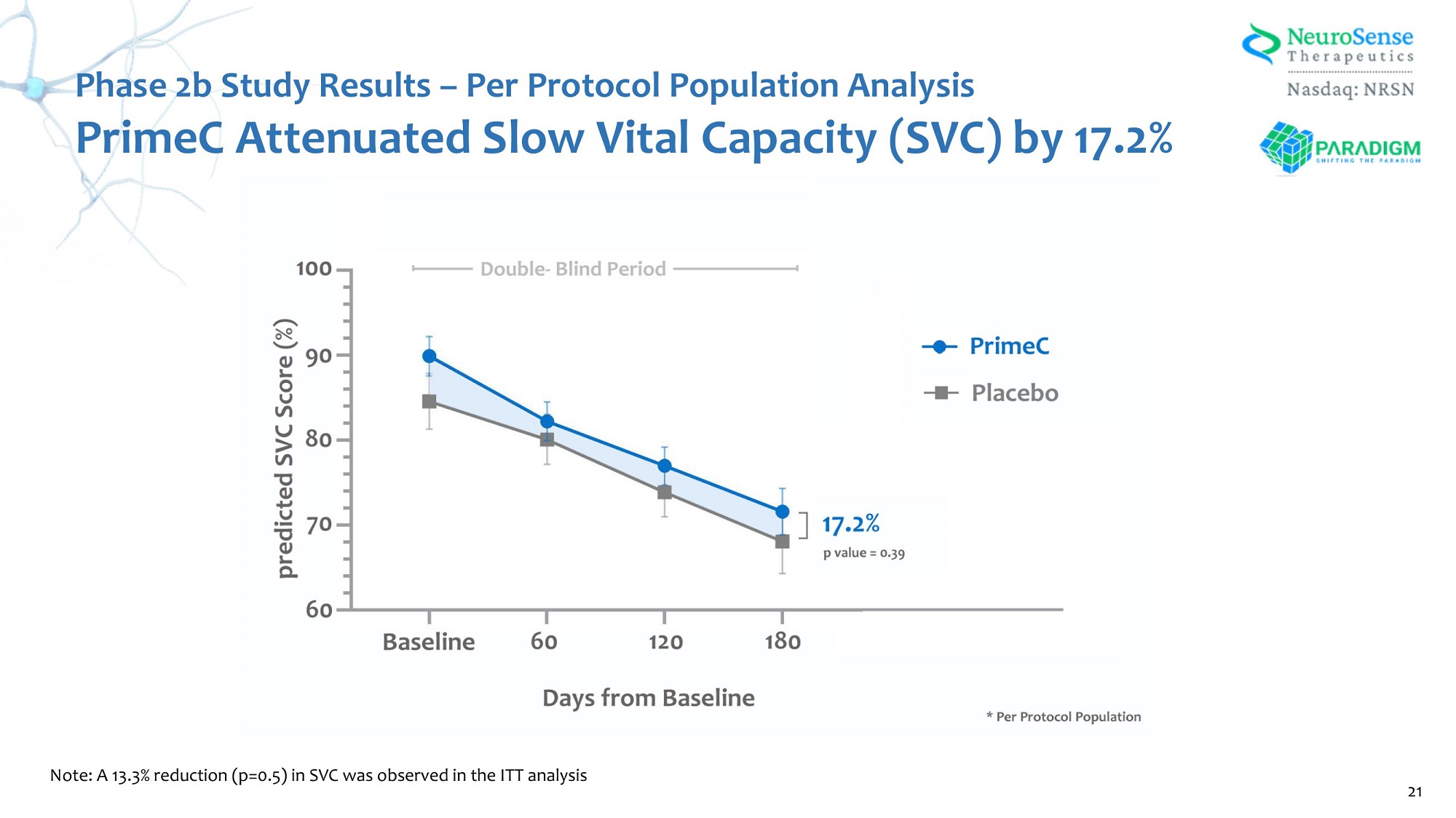
Phase 2b Study Results – Per Protocol Population Analysis PrimeC Attenuated Slow Vital Capacity (SVC) by 17.2% Note: A 13.3% reduction (p=0.5) in SVC was observed in the ITT analysis 21
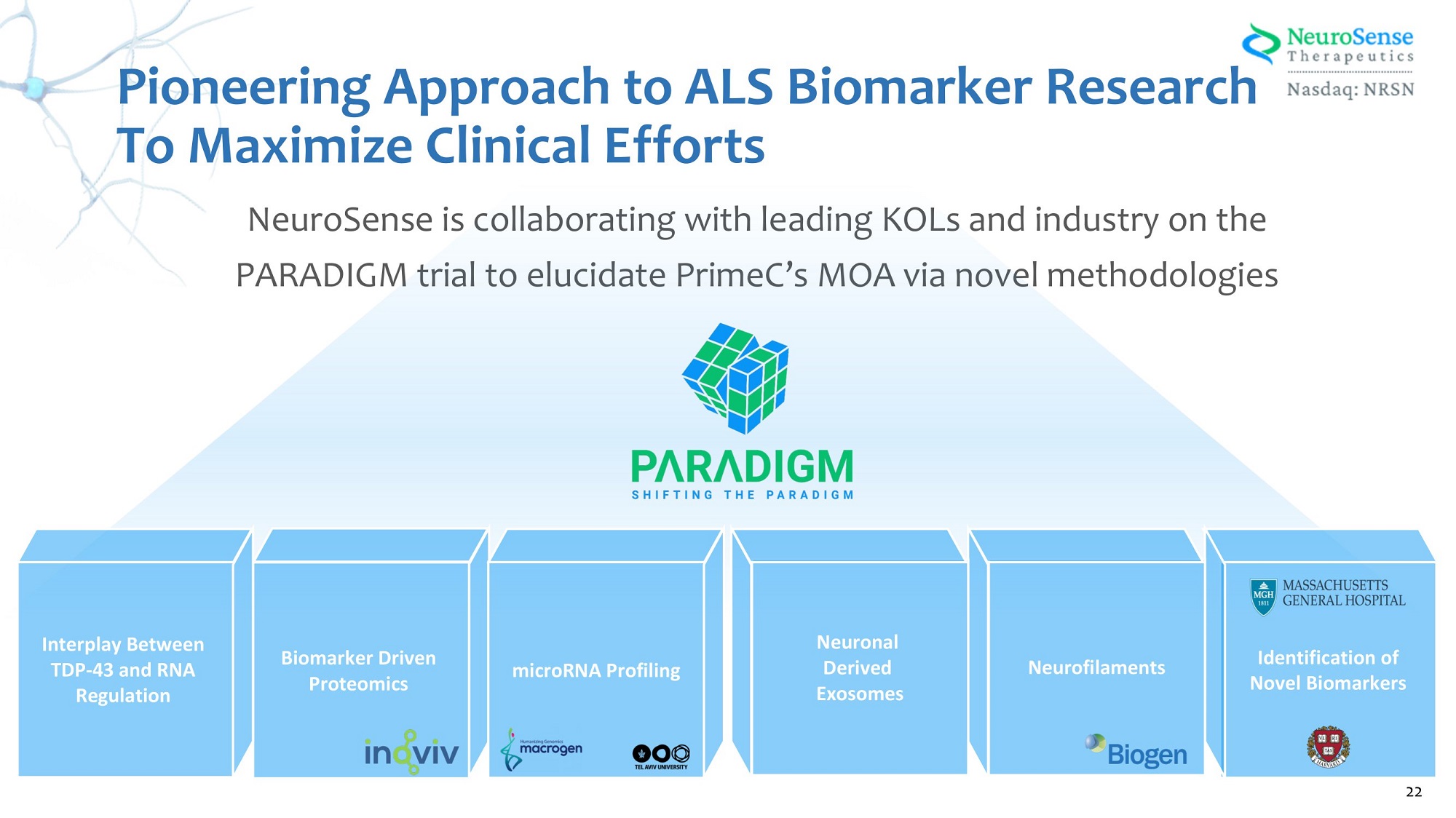
Biomarker Driven Proteomics Interplay Between TDP - 43 and RNA Regulation microRNA Profiling Identification of Novel Biomarkers Neurofilaments Neuronal Derived Exosomes Pioneering Approach to ALS Biomarker Research To Maximize Clinical Efforts NeuroSense is collaborating with leading KOLs and industry on the PARADIGM trial to elucidate PrimeC’s MOA via novel methodologies 22
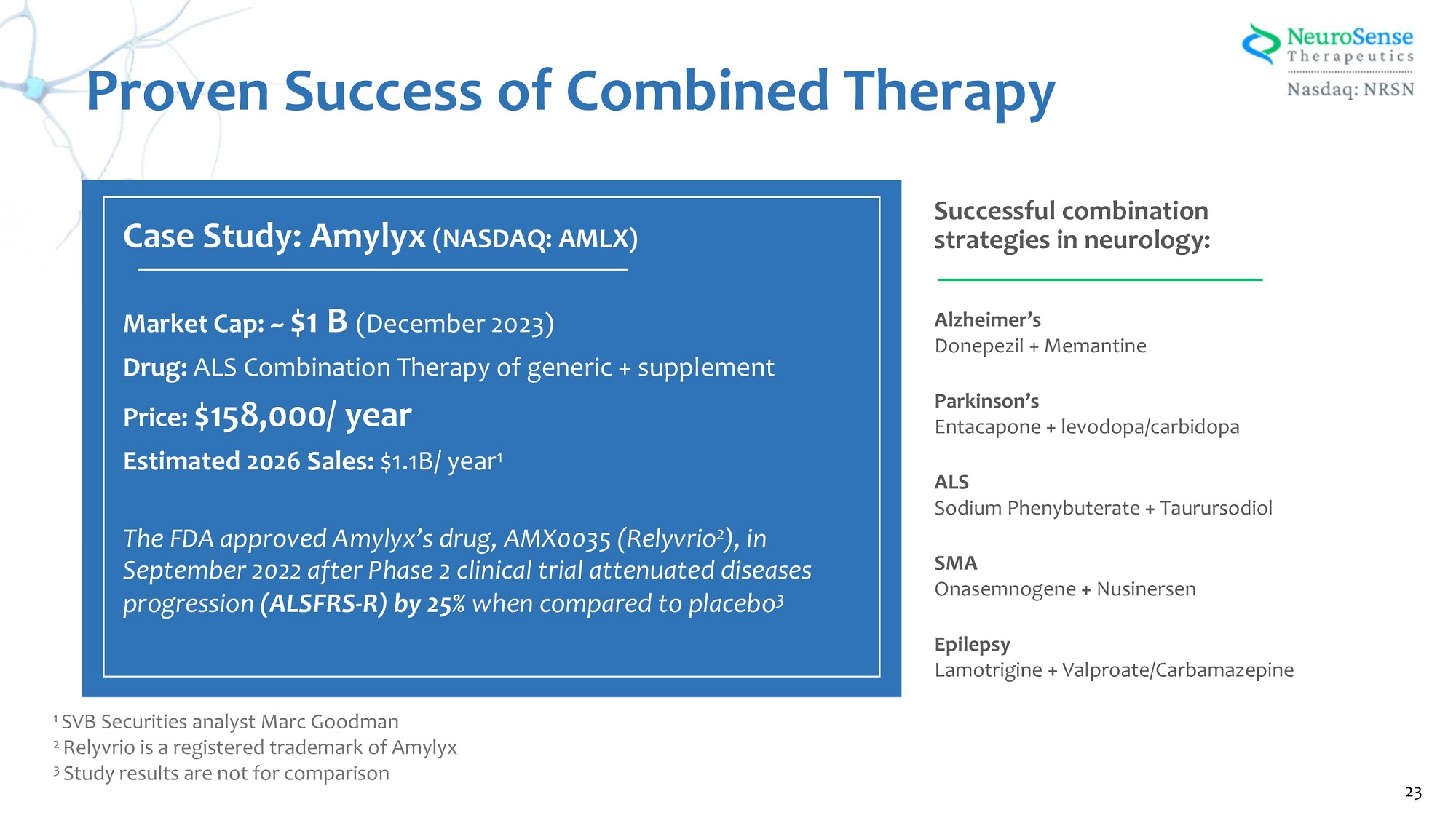
Successful combination strategies in neurology: Alzheimer’s Donepezil + Memantine Parkinson’s Entacapone + levodopa/carbidopa ALS Sodium Phenybuterate + Taurursodiol SMA Onasemnogene + Nusinersen Epilepsy Lamotrigine + Valproate/Carbamazepine Case Study: Amylyx (NASDAQ: AMLX) Market Cap: ~ $1 B (December 2023) Drug: ALS Combination Therapy of generic + supplement Price: $158,000/ year Estimated 2026 Sales: $1.1B/ year 1 The FDA approved Amylyx’s drug, AMX0035 (Relyvrio 2 ), in September 2022 after Phase 2 clinical trial attenuated diseases progression (ALSFRS - R) by 25% when compared to placebo 3 23 1 SVB Securities analyst Marc Goodman 2 Relyvrio is a registered trademark of Amylyx 3 Study results are not for comparison Proven Success of Combined Therapy
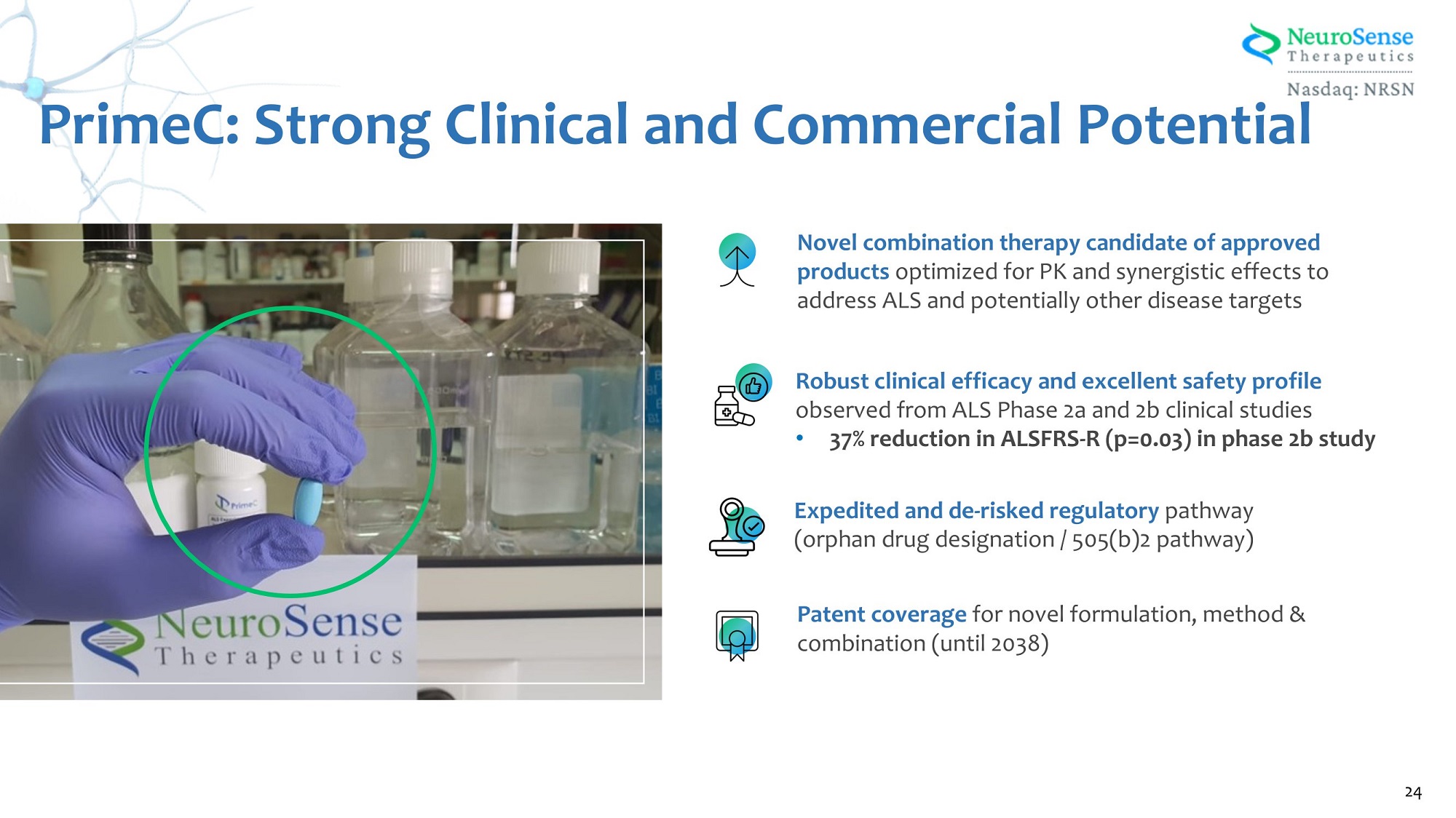
Novel combination therapy candidate of approved products optimized for PK and synergistic effects to address ALS and potentially other disease targets Robust clinical efficacy and excellent safety profile observed from ALS Phase 2a and 2b clinical studies • 37% reduction in ALSFRS - R (p=0.03) in phase 2b study Expedited and de - risked regulatory pathway (orphan drug designation / 505(b)2 pathway) Patent coverage for novel formulation, method & combination (until 2038) PrimeC: Strong Clinical and Commercial Potential 24
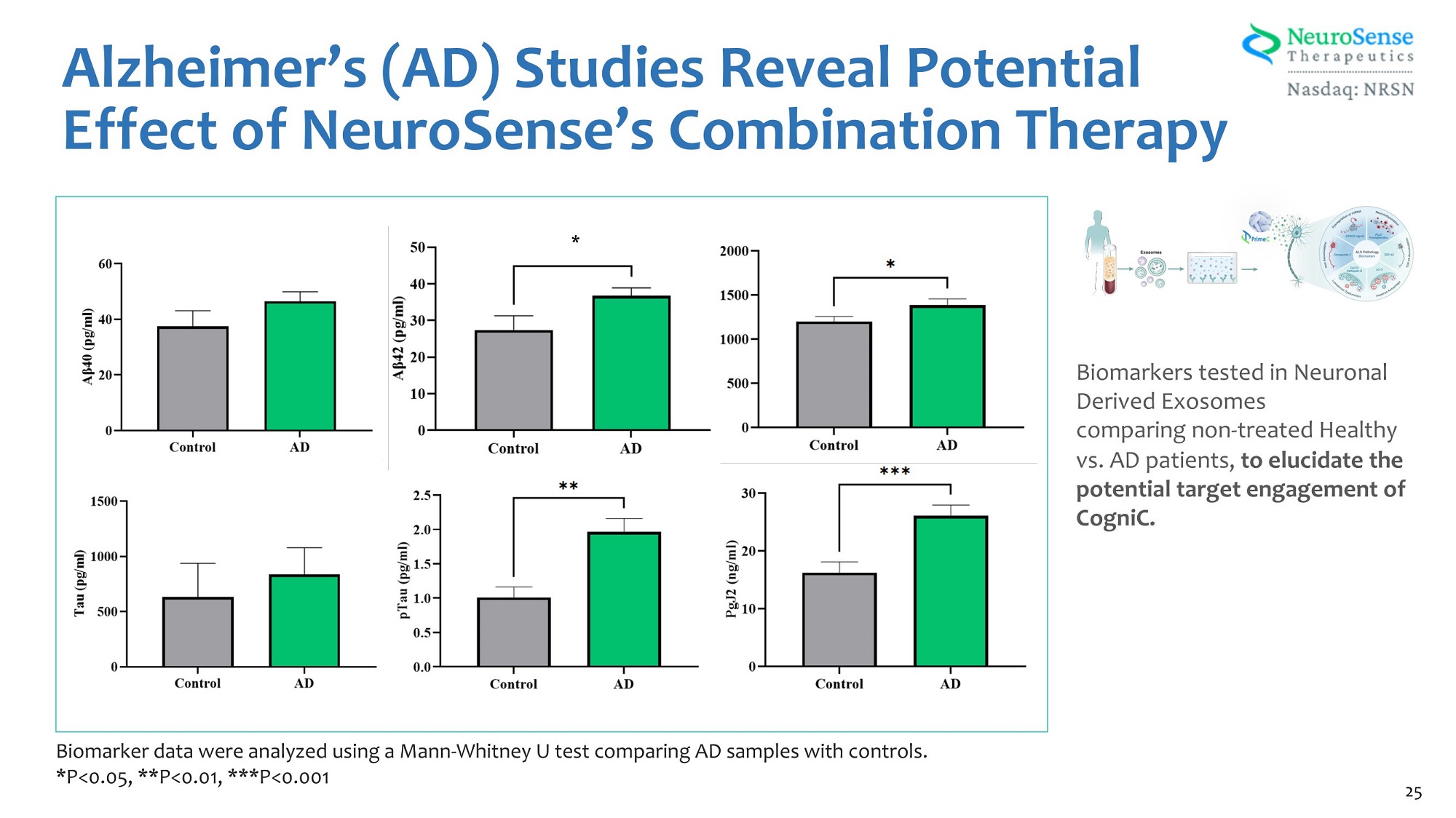
Alzheimer’s (AD) Studies Reveal Potential Effect of NeuroSense’s Combination Therapy Biomarkers tested in Neuronal Derived Exosomes comparing non - treated Healthy vs . AD patients, to elucidate the potential target engagement of CogniC . Biomarker data were analyzed using a Mann - Whitney U test comparing AD samples with controls. *P<0.05, **P<0.01, ***P<0.001 * 25
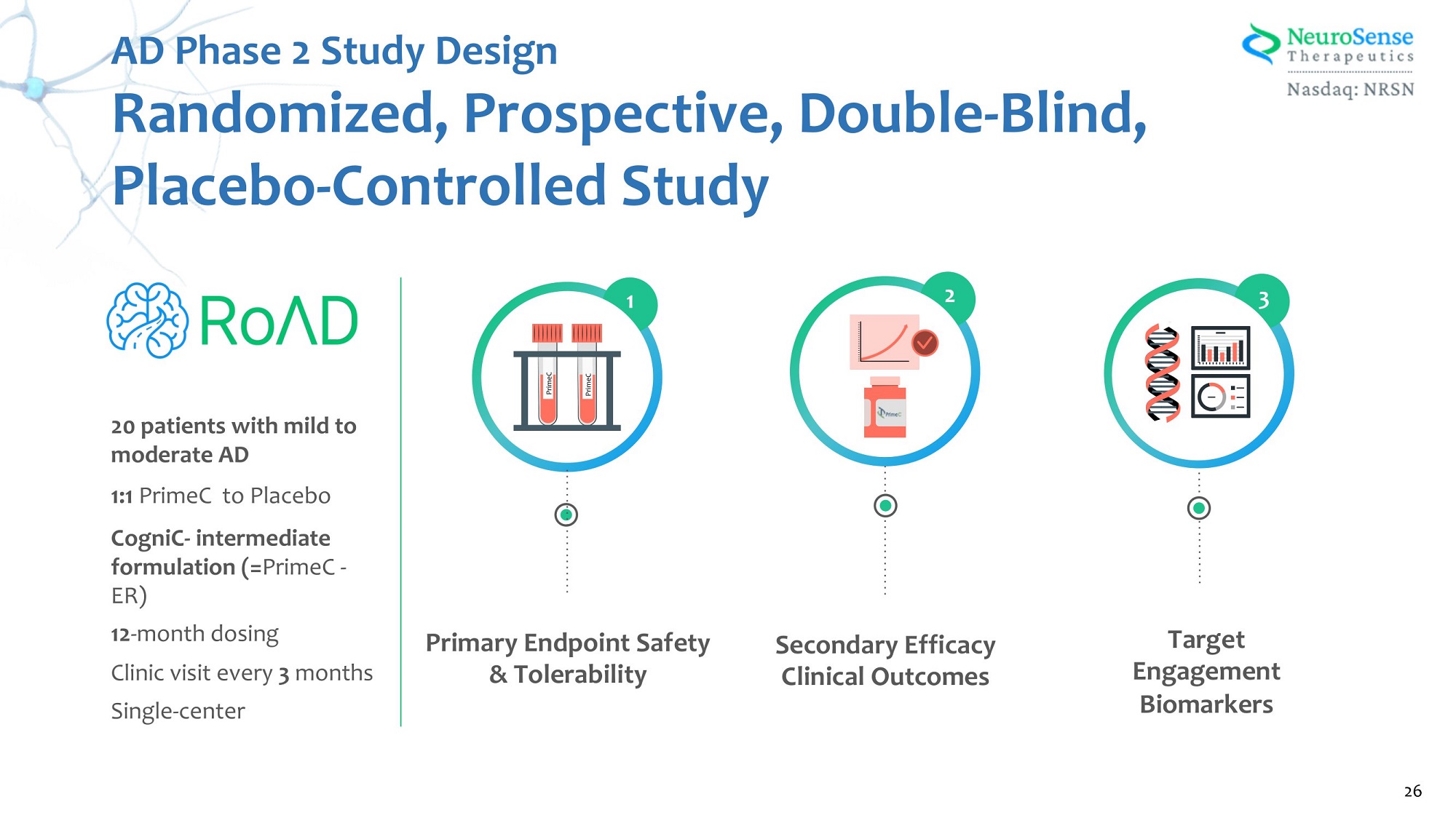
20 patients with mild to moderate AD 1:1 PrimeC to Placebo CogniC - intermediate formulation (= PrimeC - ER) 12 - month dosing Clinic visit every 3 months Single - center Target Engagement Biomarkers Secondary Efficacy Clinical Outcomes Primary Endpoint Safety & Tolerability 3 1 PrimeC PrimeC 2 AD Phase 2 Study Design 26 Randomized, Prospective, Double - Blind, Placebo - Controlled Study
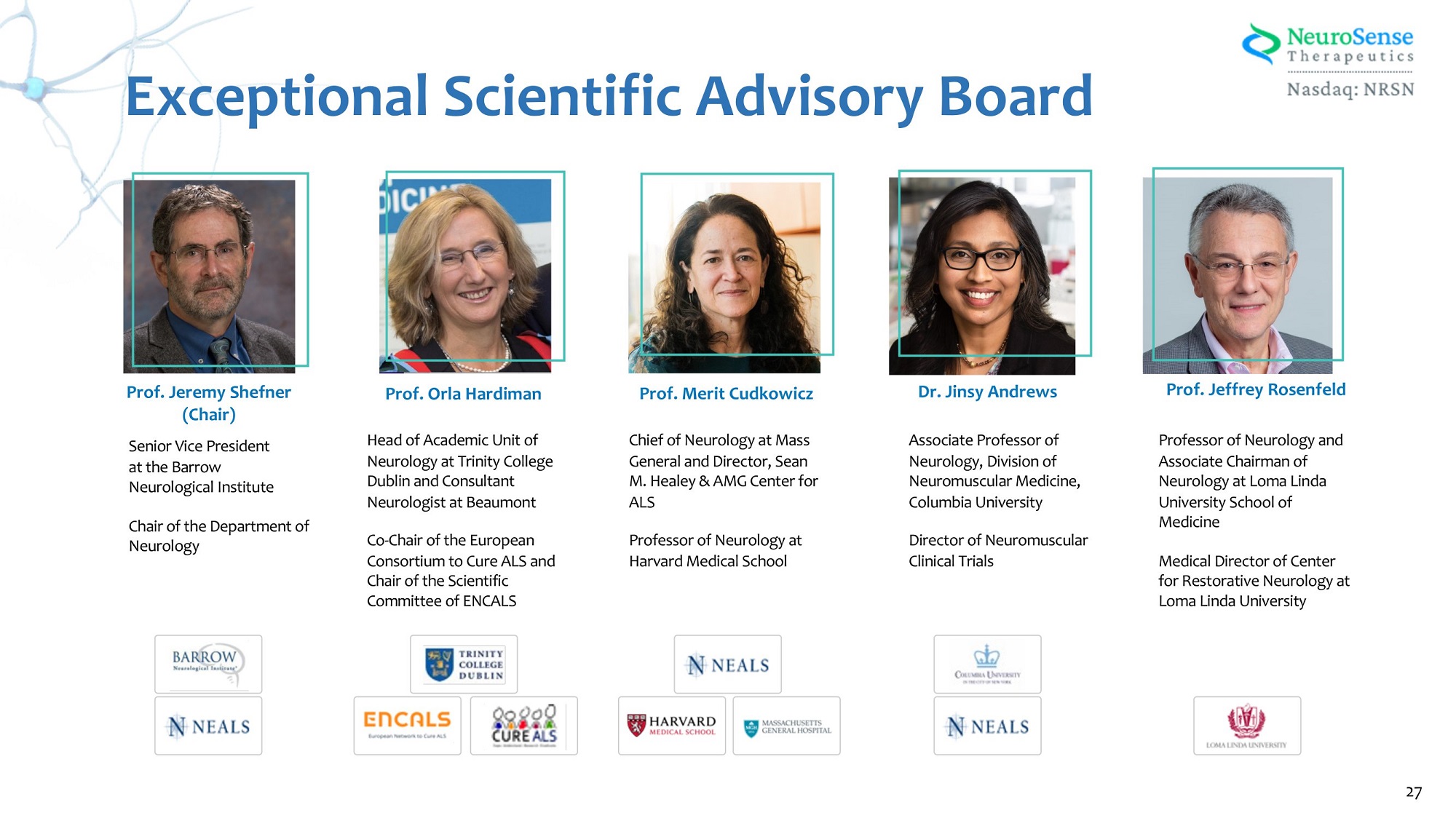
Chair of the Department of Neurology Prof. Jeremy Shefner (Chair) Senior Vice President at the Barrow Neurological Institute Dr. Jinsy Andrews Associate Professor of Neurology, Division of Neuromuscular Medicine, Columbia University Director of Neuromuscular Clinical Trials Prof. Merit Cudkowicz Chief of Neurology at Mass General and Director, Sean M. Healey & AMG Center for ALS Professor of Neurology at Harvard Medical School Prof. Jeffrey Rosenfeld Professor of Neurology and Associate Chairman of Neurology at Loma Linda University School of Medicine Medical Director of Center for Restorative Neurology at Loma Linda University Prof. Orla Hardiman Head of Academic Unit of Neurology at Trinity College Dublin and Consultant Neurologist at Beaumont Co - Chair of the European Consortium to Cure ALS and Chair of the Scientific Committee of ENCALS Exceptional Scientific Advisory Board 27
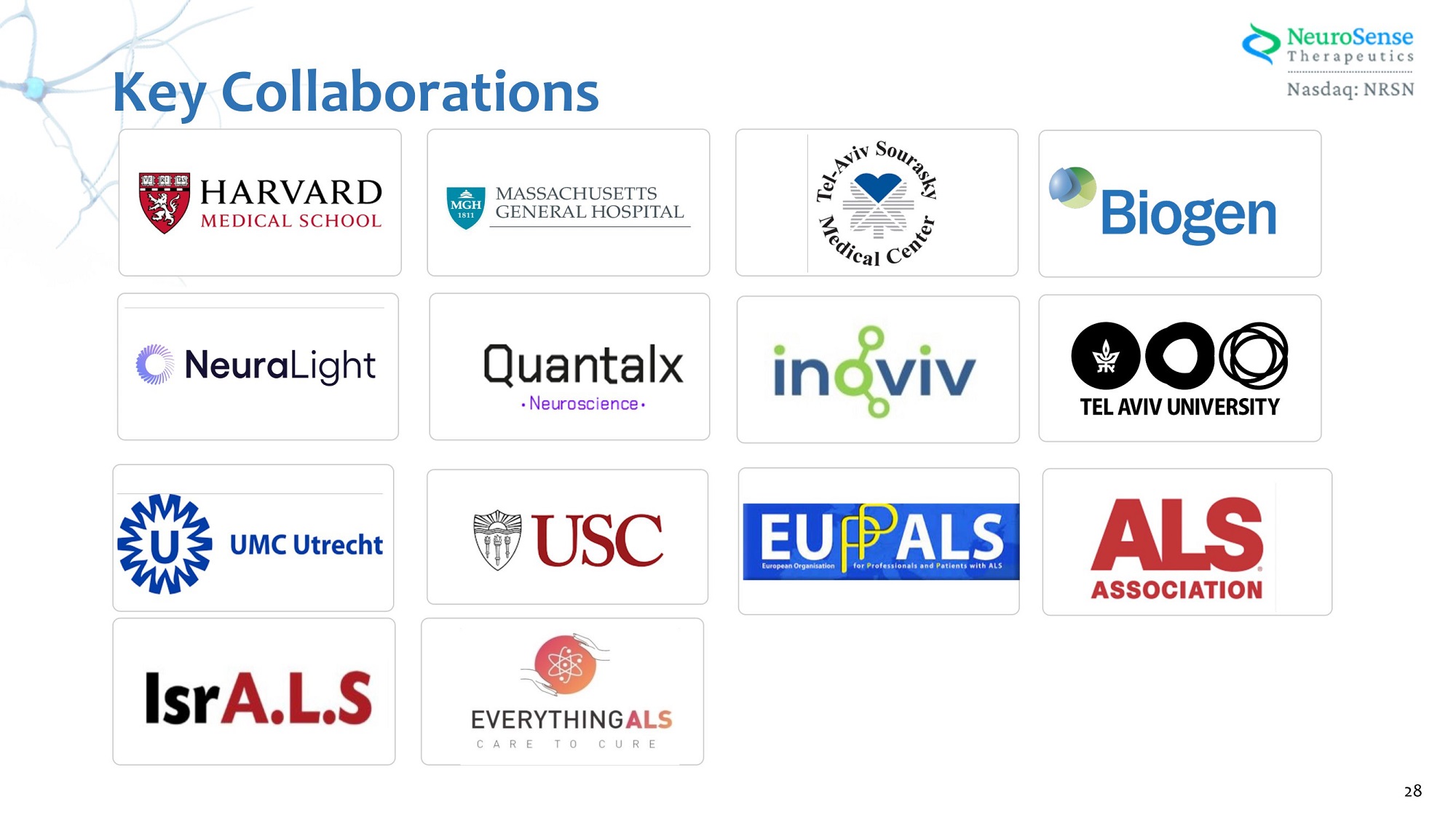
Key Collaborations 28
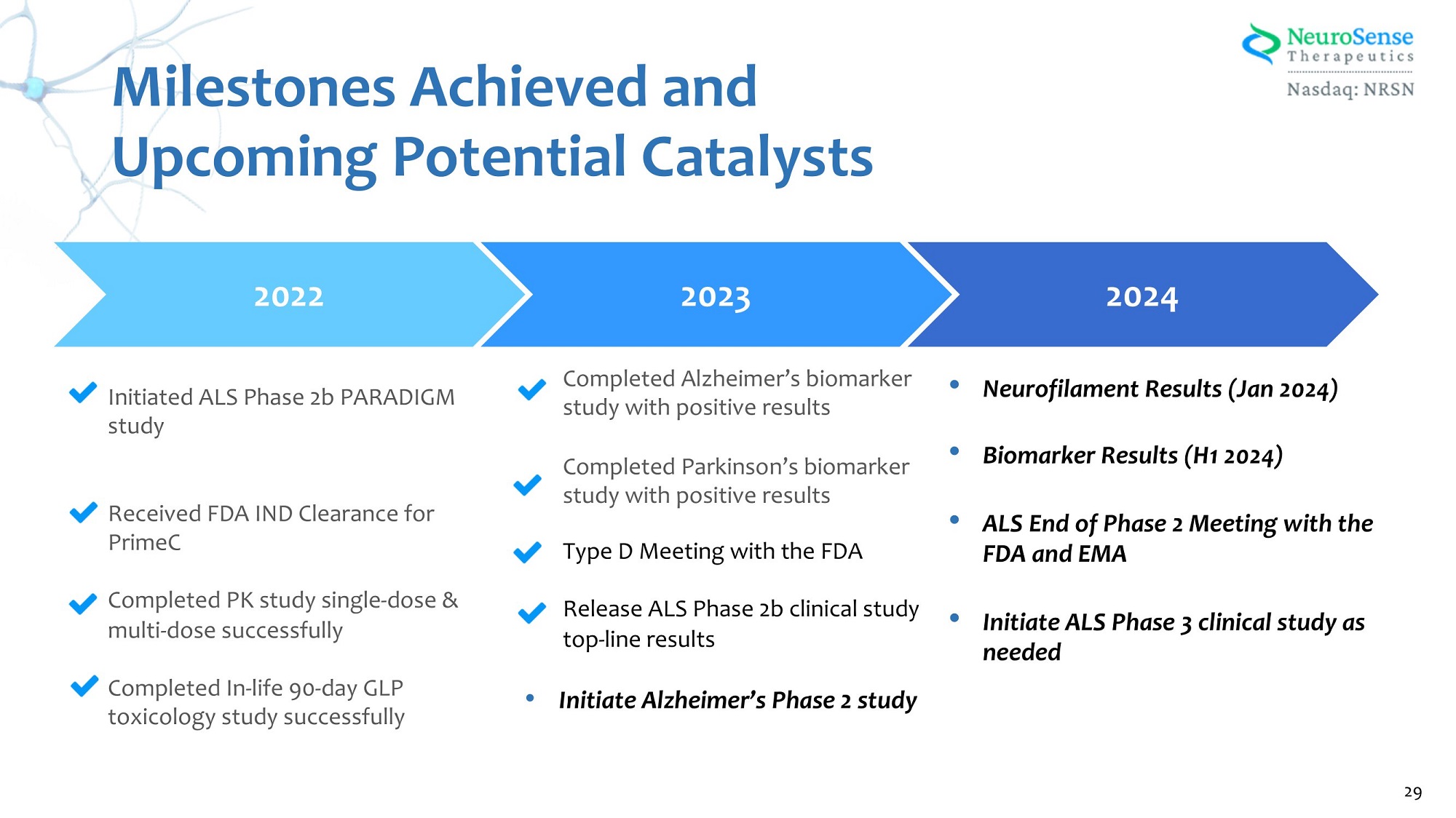
• Neurofilament Results (Jan 2024) • Biomarker Results (H1 2024) • ALS End of Phase 2 Meeting with the FDA and EMA • Initiate ALS Phase 3 clinical study as needed Initiated ALS Phase 2b PARADIGM study Received FDA IND Clearance for PrimeC Completed PK study single - dose & multi - dose successfully Completed In - life 90 - day GLP toxicology study successfully 2022 2023 2024 Completed Alzheimer’s biomarker study with positive results Completed Parkinson’s biomarker study with positive results Type D Meeting with the FDA Release ALS Phase 2b clinical study top - line results Milestones Achieved and Upcoming Potential Catalysts 29 • Initiate Alzheimer’s Phase 2 study
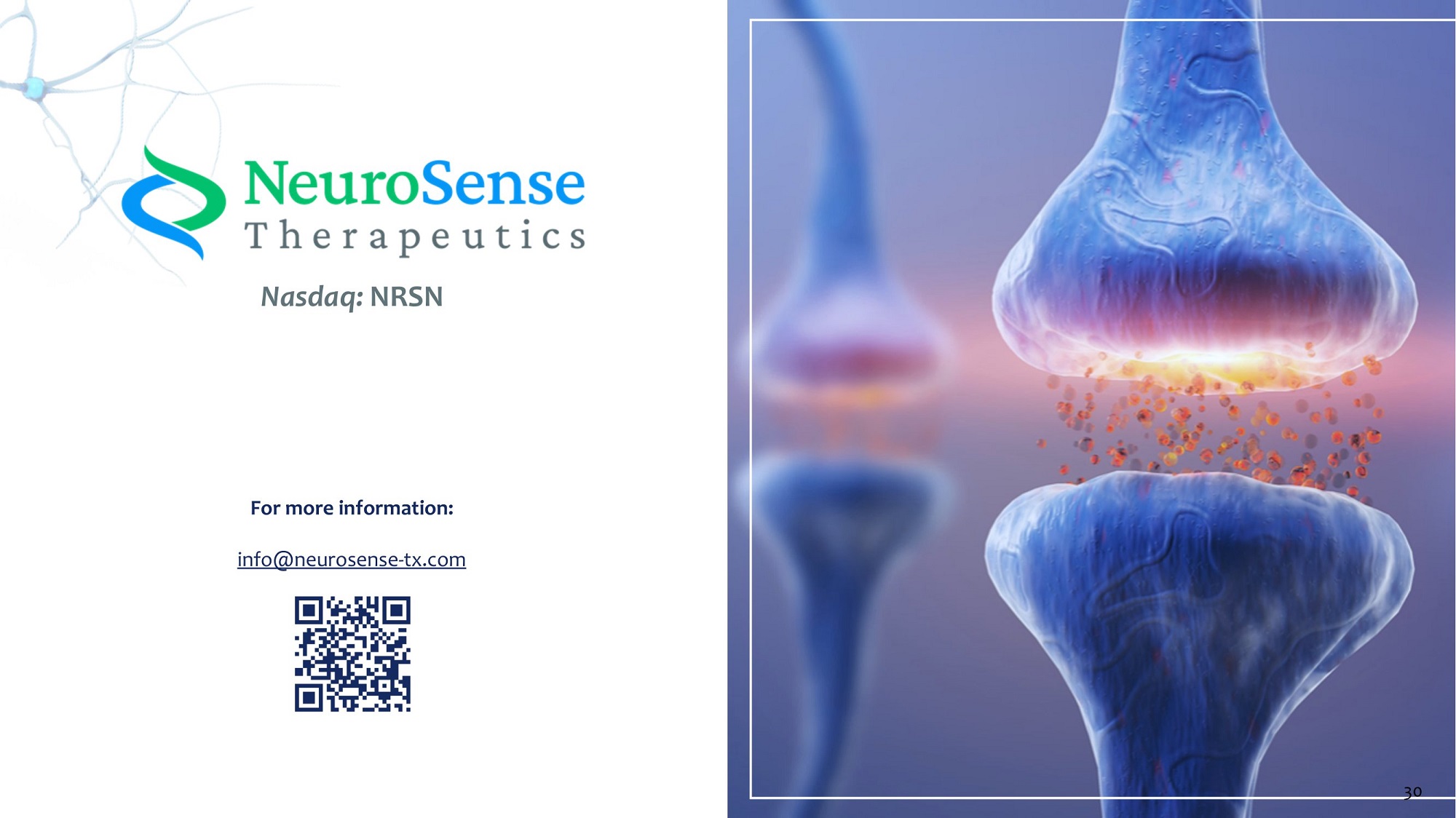
Nasdaq: NRSN For more information: info@neurosense - tx.com 30
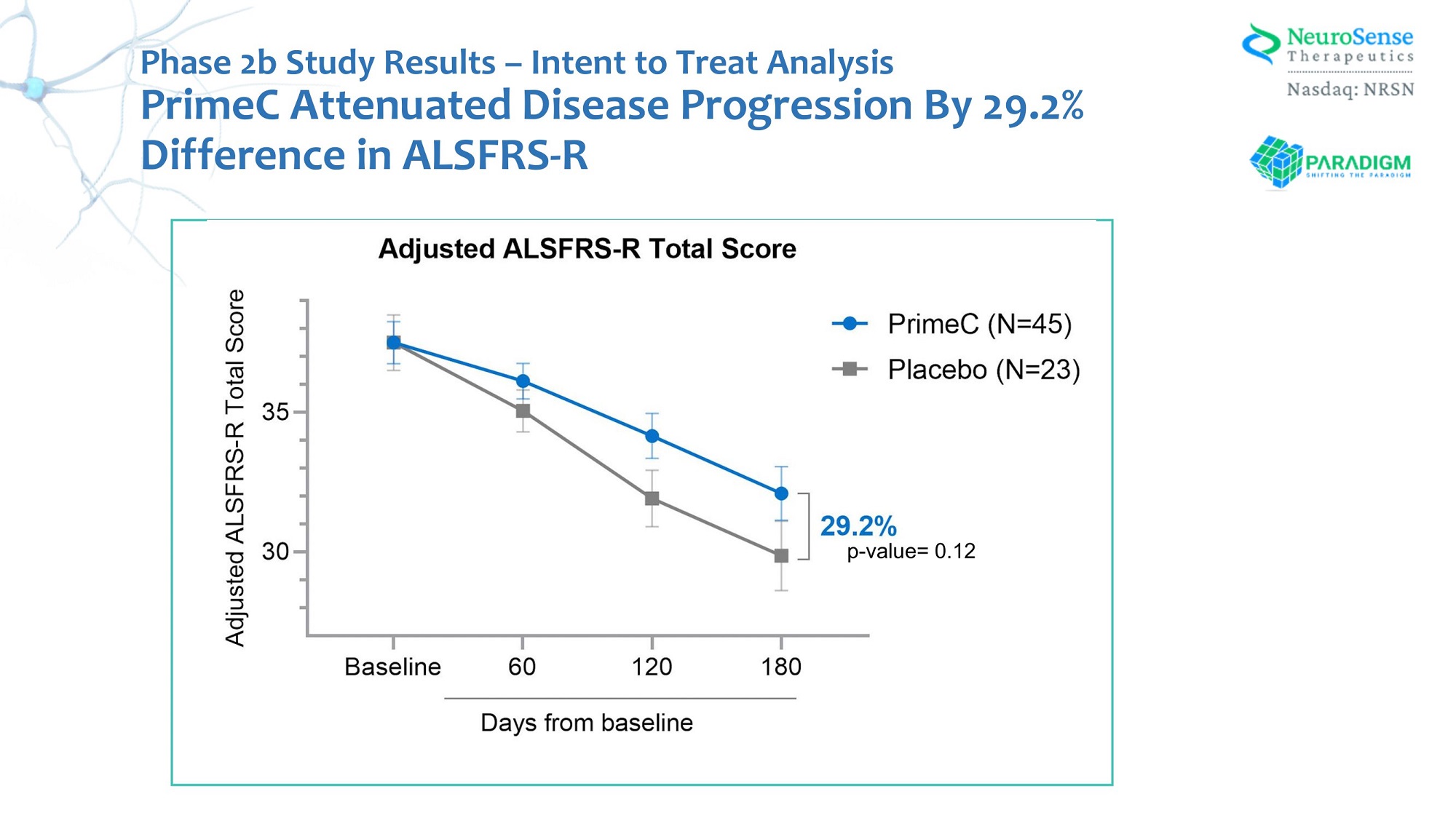
Phase 2b Study Results – Intent to Treat Analysis PrimeC Attenuated Disease Progression By 29.2% Difference in ALSFRS - R p - value= 0.12
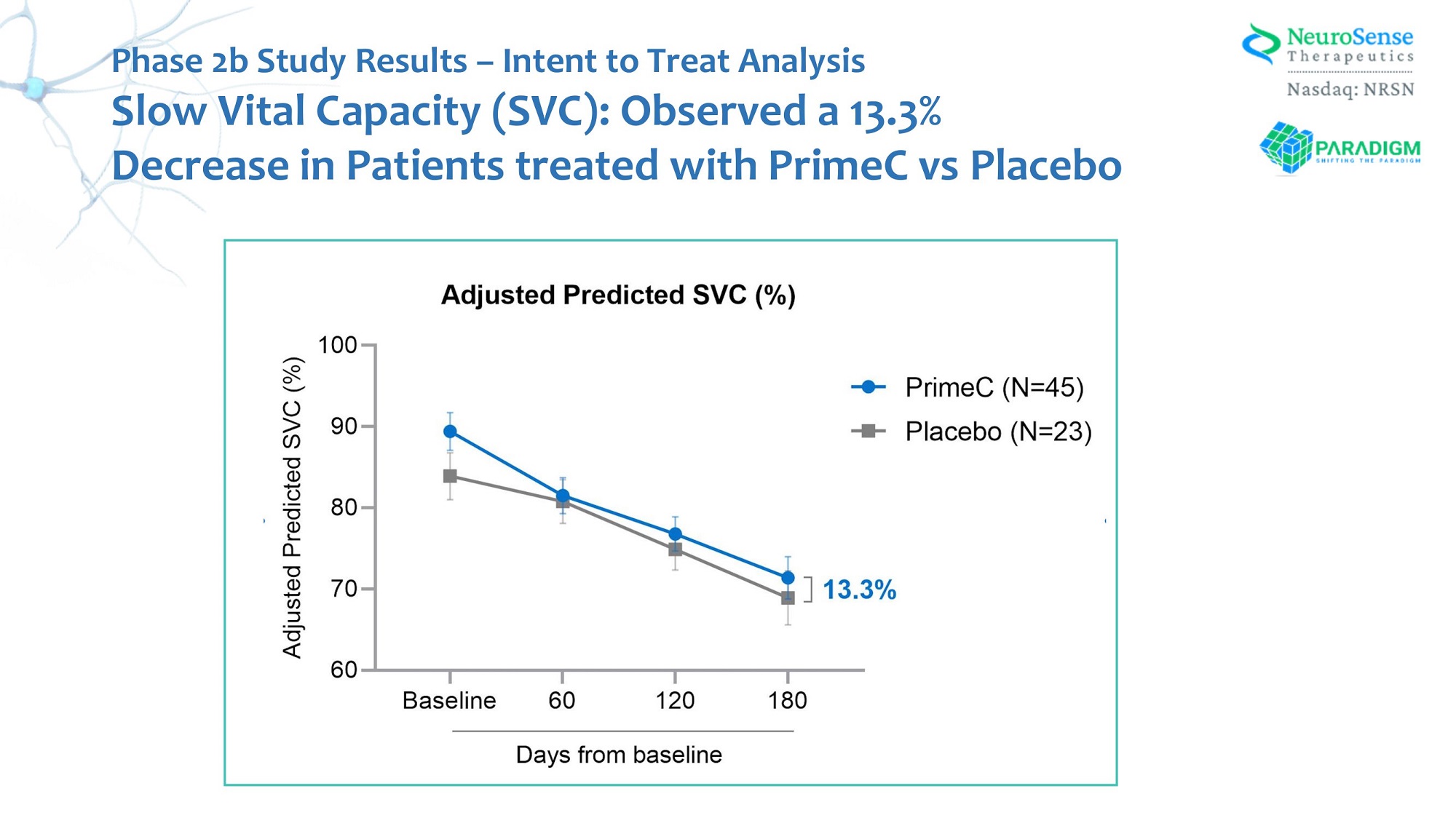
p - value= 0.5 Phase 2b Study Results – Intent to Treat Analysis Slow Vital Capacity (SVC): Observed a 13.3% Decrease in Patients treated with PrimeC vs Placebo
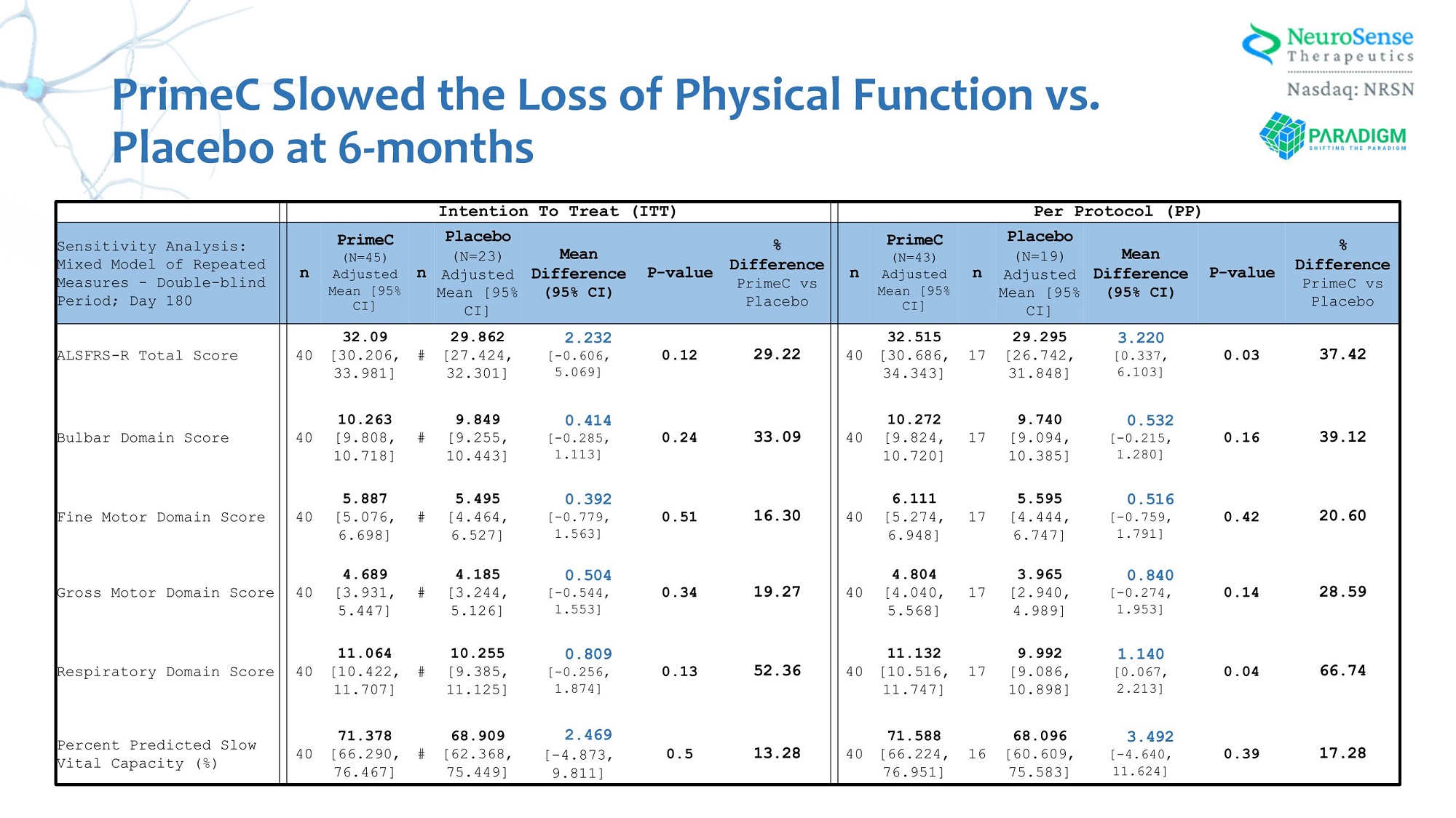
PrimeC Slowed the Loss of Physical Function vs. Placebo at 6 - months Per Protocol (PP) Intention To Treat (ITT) PrimeC Placebo % (N=43) (N=19) Mean n Adjusted n Adjusted Difference P - value Difference Mean [95% Mean [95% (95% CI) PrimeC vs CI] CI] Placebo PrimeC Placebo % (N=45) (N=23) Mean n Adjusted n Adjusted Difference P - value Difference Mean [95% Mean [95% (95% CI) PrimeC vs CI] CI] Placebo Sensitivity Analysis: Mixed Model of Repeated Measures - Double - blind Period; Day 180 32.515 29.295 3.220 32.09 29.862 2.232 40 [30.686, 17 [26.742, [0.337, 0.03 37.42 40 [30.206, # [27.424, [ - 0.606, 0.12 29.22 ALSFRS - R Total Score 34.343] 31.848] 6.103] 33.981] 32.301] 5.069] 10.272 9.740 0.532 10.263 9.849 0.414 40 [9.824, 17 [9.094, [ - 0.215, 0.16 39.12 40 [9.808, # [9.255, [ - 0.285, 0.24 33.09 Bulbar Domain Score 10.720] 10.385] 1.280] 10.718] 10.443] 1.113] 6.111 5.595 0.516 5.887 5.495 0.392 40 [5.274, 17 [4.444, [ - 0.759, 0.42 20.60 40 [5.076, # [4.464, [ - 0.779, 0.51 16.30 Fine Motor Domain Score 6.948] 6.747] 1.791] 6.698] 6.527] 1.563] 4.804 3.965 0.840 4.689 4.185 0.504 40 [4.040, 17 [2.940, [ - 0.274, 0.14 28.59 40 [3.931, # [3.244, [ - 0.544, 0.34 19.27 Gross Motor Domain Score 5.568] 4.989] 1.953] 5.447] 5.126] 1.553] 11.132 9.992 1.140 11.064 10.255 0.809 40 [10.516, 17 [9.086, [0.067, 0.04 66.74 40 [10.422, # [9.385, [ - 0.256, 0.13 52.36 Respiratory Domain Score 11.747] 10.898] 2.213] 11.707] 11.125] 1.874] 71.588 68.096 3.492 40 [66.224, 16 [60.609, [ - 4.640, 0.39 17.28 76.951] 75.583] 11.624] 71.378 68.909 2.469 40 [66.290, # [62.368, [ - 4.873, 0.5 13.28 76.467] 75.449] 9.811] Percent Predicted Slow Vital Capacity (%)
NeuroSense Therapeutics (NASDAQ:NRSN)
Historical Stock Chart
From Mar 2024 to Apr 2024

NeuroSense Therapeutics (NASDAQ:NRSN)
Historical Stock Chart
From Apr 2023 to Apr 2024
